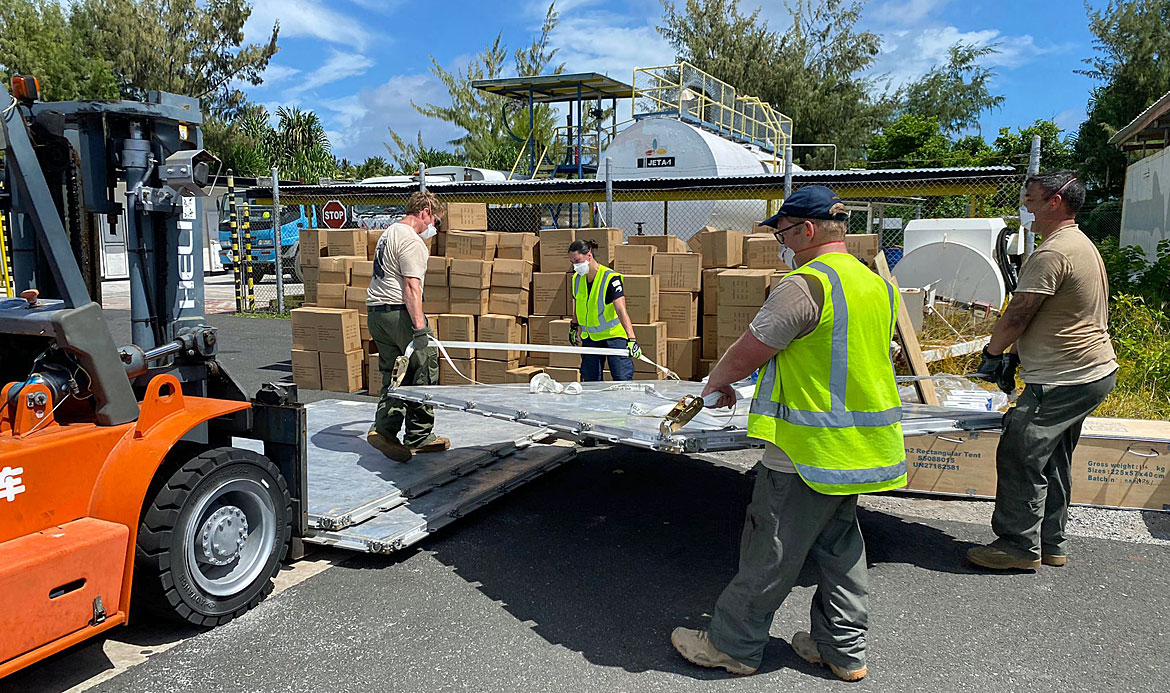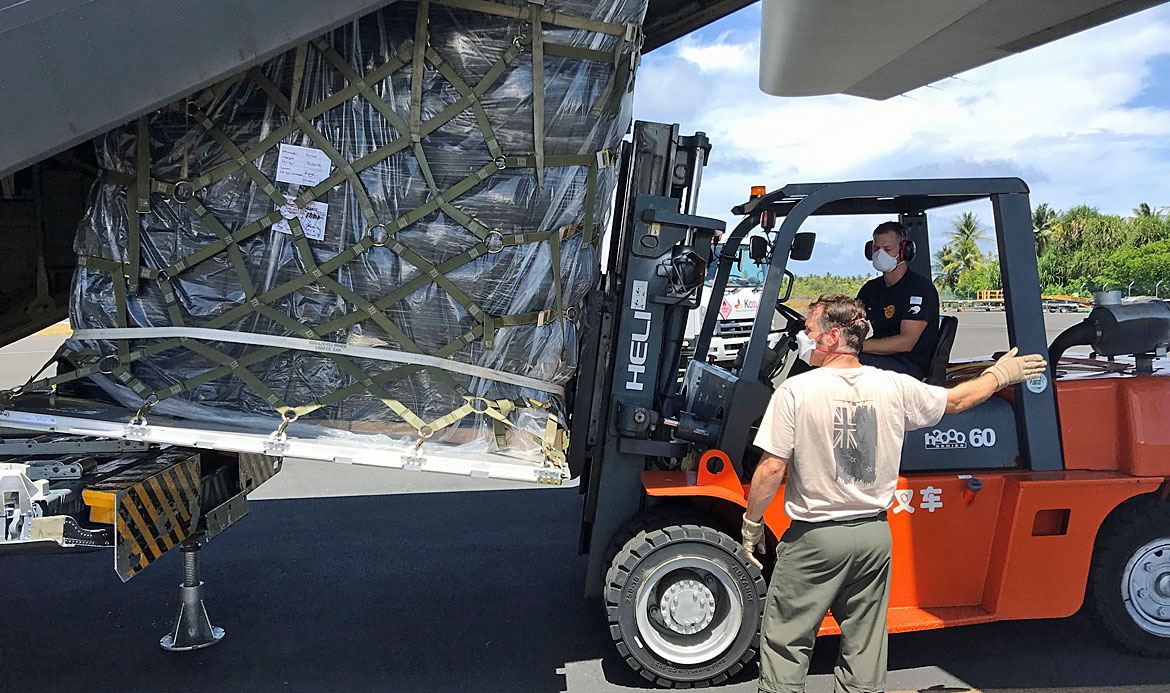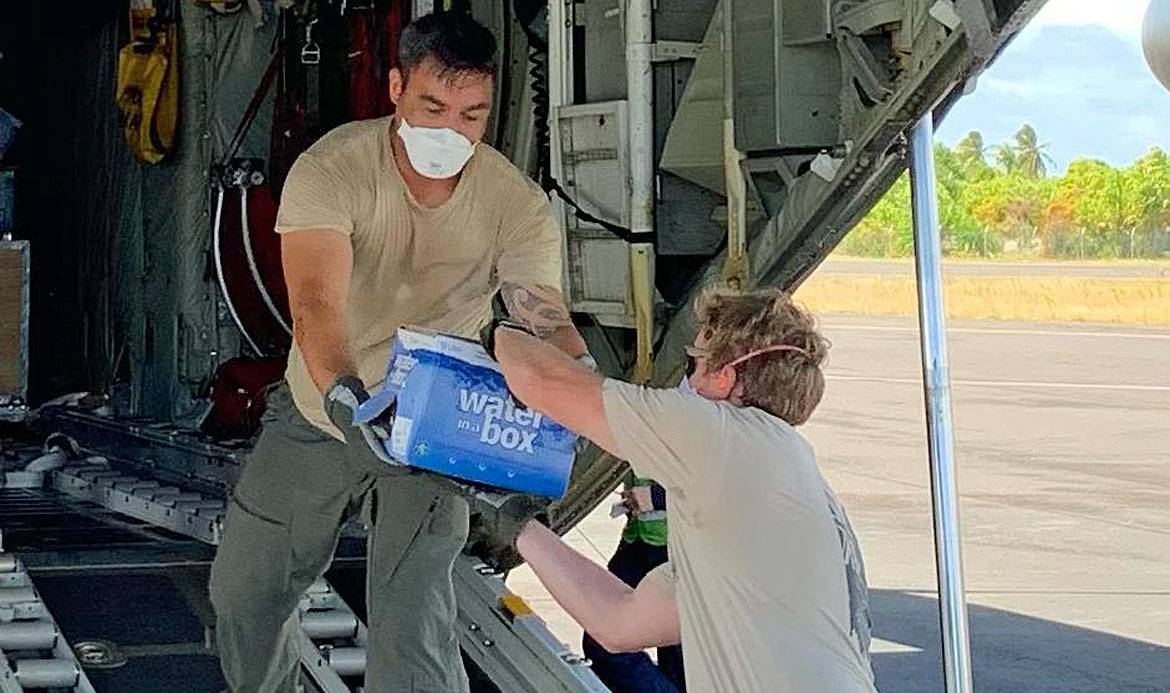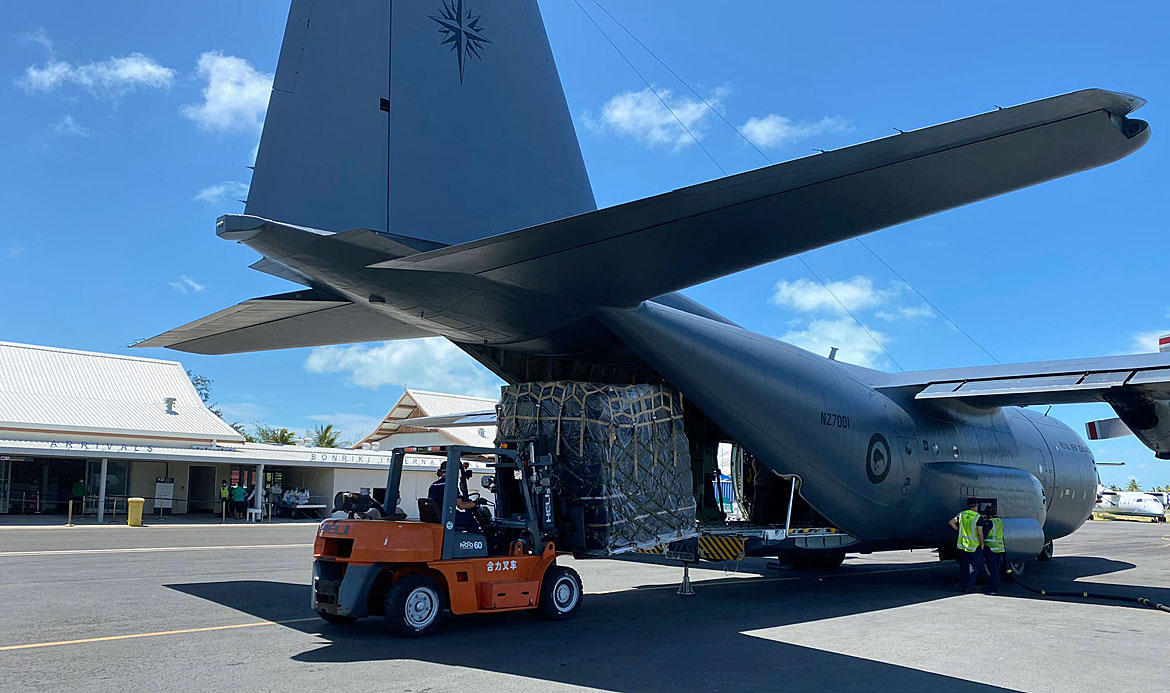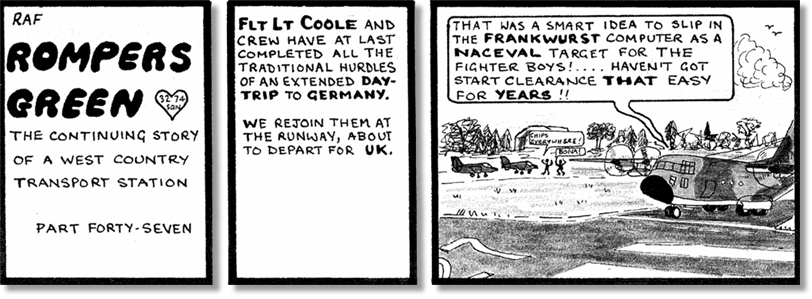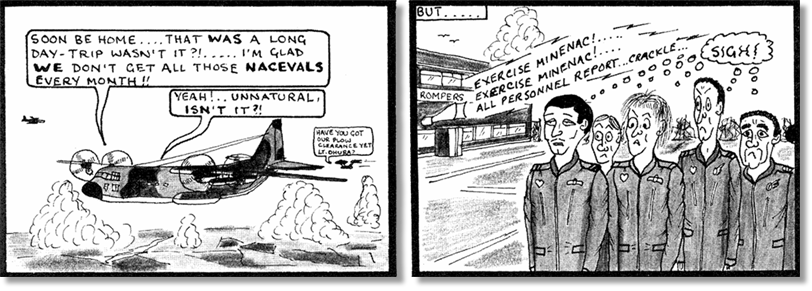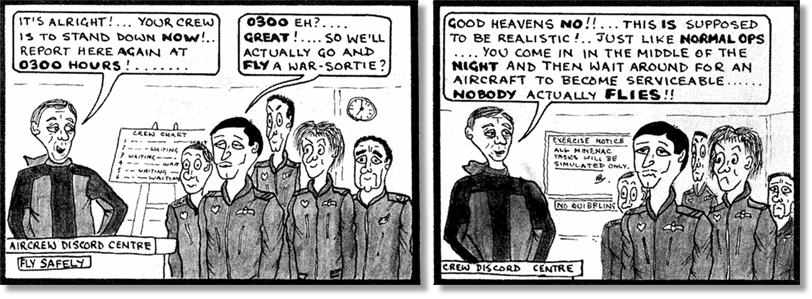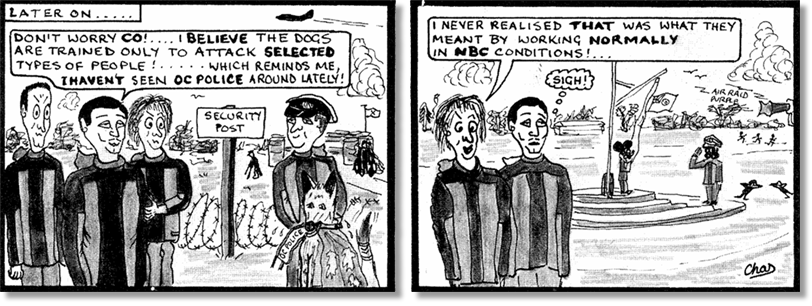
New Royal Air Force jets to enhance UK's international presence

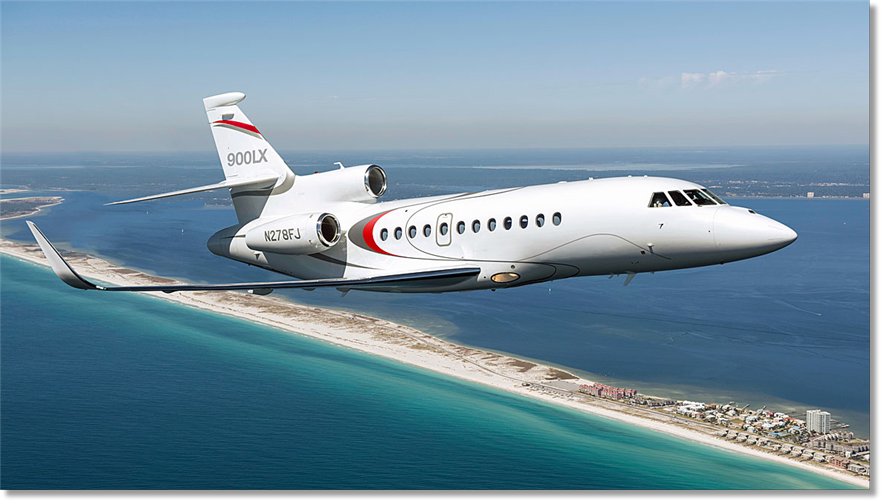
Under a new £80 million contract with Bristol-based Centreline, four BAe146 aircraft, will be replaced by two more sustainable aircraft to continue the UK’s global engagement.
The new planes will be more sustainable thanks to their smaller engines, leading to a reduction in fuel burn and emissions. They will also be able to fly further, providing the UK greater opportunity to engage with key allies and partners.
The contract with Centreline, placed by Defence Equipment and Support (DE&S), the MOD’s procurement arm, includes the purchase of two Dassault 900LX aircraft and two years of initial support, plus three option years if required.
The new planes will be more sustainable thanks to their smaller engines, leading to a reduction in fuel burn and emissions. They will also be able to fly further, providing the UK greater opportunity to engage with key allies and partners.
The contract with Centreline, placed by Defence Equipment and Support (DE&S), the MOD’s procurement arm, includes the purchase of two Dassault 900LX aircraft and two years of initial support, plus three option years if required.
"The Defence Equipment and Support and RAF teams have done an incredible job to procure these modern and efficient aircraft. I look forward to seeing them support the UK Defence Mission and our wider strategic partnerships."
Air Commodore Martin
RAF’s Programme Lead
The two-phase programme will see the aircraft initially operated by a mixed crew of civilian and RAF personnel. The aircraft will be upgraded with missile jamming systems and military communications to deliver full capability and crewed by RAF personnel.
"I am incredibly proud of the team at Defence Equipment and Support who have worked innovatively and at pace to negotiate a contract that is exceptional value for money and ensures this critical capability is available."
CEO Sir Simon Bollom
Defence Equipment and Support
The Integrated Review and Defence Command Paper set out a bold and global vision stressing the importance of soft power, enhancing our international presence, developing on current relationships and building new ones.
After four decades of service, two BAe 146 aircraft are being preserved at the British Airliner Collection at Duxford, Cambridgeshire, and the South Wales Aviation Museum at St Athan in South Glamorgan. The remaining two aircraft have been bought by a Civilian Operator.
raf.mod.uk

From: Duane Bach, Carrying Place, ON
Subject: Re: UKMAMS OBA OBB #013122
Thanks for a great newsletter Tony, especially the tribute to the "Buffalo Nine" who were shot down in August 1974.
My wife of 46 years was married to the Loadmaster (Bruce) and I was a good friend of his and a pallbearer at his funeral. I have logged over 700 hours on the Buff and instructed on it at the training squadron.
Thanks again Tony for the super job you're doing...
Cheers, Duane
Subject: Re: UKMAMS OBA OBB #013122
Thanks for a great newsletter Tony, especially the tribute to the "Buffalo Nine" who were shot down in August 1974.
My wife of 46 years was married to the Loadmaster (Bruce) and I was a good friend of his and a pallbearer at his funeral. I have logged over 700 hours on the Buff and instructed on it at the training squadron.
Thanks again Tony for the super job you're doing...
Cheers, Duane
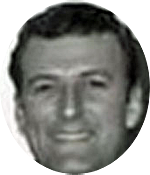

From: Brian Harper, Glenwood, NL
Subject: Warrant Officers I have Known
Hi Tony,
Just read the latest news, and reading through it I noticed one name missing, WO George "Clipboard" North. He was my WO on "C" shift in the 1970's when I was Lyneham.
The articles bought back many memories of my tours.
Brian
Subject: Warrant Officers I have Known
Hi Tony,
Just read the latest news, and reading through it I noticed one name missing, WO George "Clipboard" North. He was my WO on "C" shift in the 1970's when I was Lyneham.
The articles bought back many memories of my tours.
Brian


From: Gerry Davis, Bedminster, Somerset
Subject: Getting Older
Hi Tony,
After reading the latest newsletter and hearing about those that are not with us anymore, it really puts life into perspective. It's more than a fortnight ago when I left the RAF in 1971, after doing my bit shifting stuff around on those long-departed Transport Command aircraft. Being an octogenarian there doesn’t seem to be many about who I served with, and I would probably look lost amongst those now serving, who I read, on your monthly report, that these days are doing a splendid job around the world on the modern-day flying machines.
Those days we served are firmly committed to our memories and never fade, that’s why we follow your submissions. It's also rewarding to keep in touch with many who we served with, even those who were different trades, and of course those of us who joined up when only 15 years old (like you) as Boy Entrants (in my case in 1956). Let's face it, there are those these days that cannot envisage young lads leaving home at such a tender age and inexperienced to the harsh realities that we were subjected to.
It never seems to amaze me in knowing that contact with others of a similar mindset can be so rewarding. I have as a result of several requests initiated a group meeting of ex-Boy Entrants, of all trades, even for those who joined as adults, in any trade. Our next meeting, entitled, ‘Boy Entrant West Country Meet-Up’, our fourth gathering, held at a pub between Bristol and Weston-Super-Mare will be announced for February 22nd, on Facebook. Each one of our meetings so far has proven to be a success with increasing numbers on each occasion. The camaraderie at these events is something that cannot to be found elsewhere.
Regards
Gerry
Subject: Getting Older
Hi Tony,
After reading the latest newsletter and hearing about those that are not with us anymore, it really puts life into perspective. It's more than a fortnight ago when I left the RAF in 1971, after doing my bit shifting stuff around on those long-departed Transport Command aircraft. Being an octogenarian there doesn’t seem to be many about who I served with, and I would probably look lost amongst those now serving, who I read, on your monthly report, that these days are doing a splendid job around the world on the modern-day flying machines.
Those days we served are firmly committed to our memories and never fade, that’s why we follow your submissions. It's also rewarding to keep in touch with many who we served with, even those who were different trades, and of course those of us who joined up when only 15 years old (like you) as Boy Entrants (in my case in 1956). Let's face it, there are those these days that cannot envisage young lads leaving home at such a tender age and inexperienced to the harsh realities that we were subjected to.
It never seems to amaze me in knowing that contact with others of a similar mindset can be so rewarding. I have as a result of several requests initiated a group meeting of ex-Boy Entrants, of all trades, even for those who joined as adults, in any trade. Our next meeting, entitled, ‘Boy Entrant West Country Meet-Up’, our fourth gathering, held at a pub between Bristol and Weston-Super-Mare will be announced for February 22nd, on Facebook. Each one of our meetings so far has proven to be a success with increasing numbers on each occasion. The camaraderie at these events is something that cannot to be found elsewhere.
Regards
Gerry


RNZAF delivers aid to Kiribati
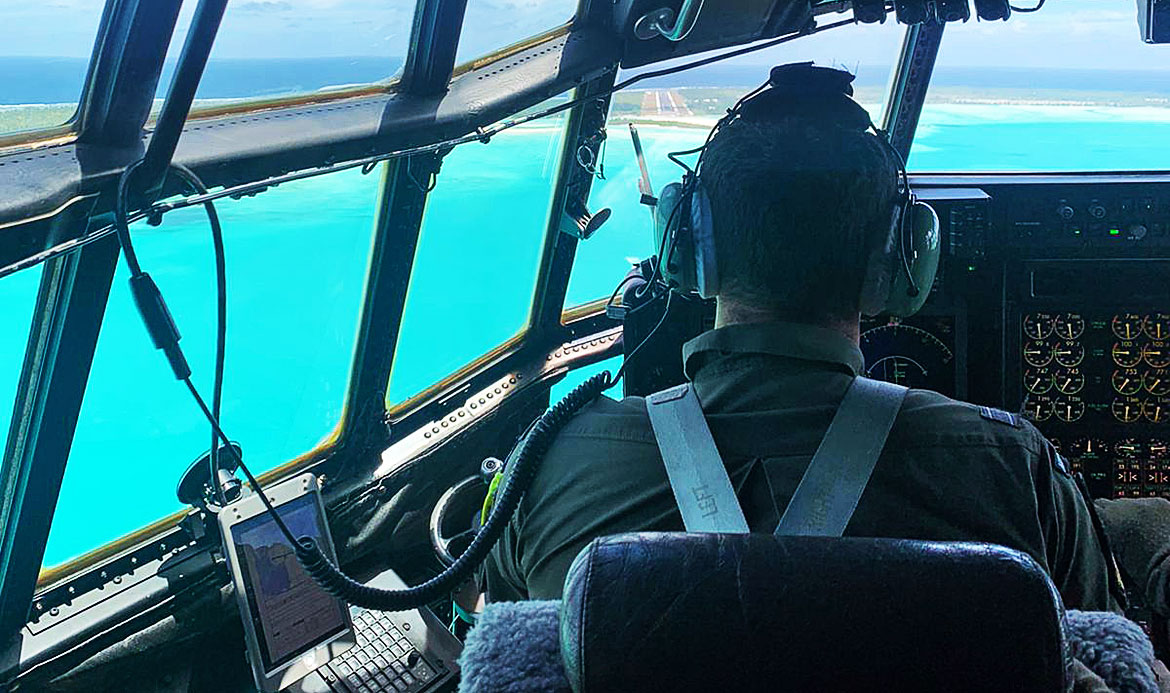
17 February, 2022. One of our Hercules aircraft and crew from No. 40 Squadron delivered more than 13,000kg of cargo to Kiribati this week. The cargo included Personal Protective Equipment, medical equipment, a generator and water. Most of the cargo was for the Kiribati Ministry of Health and Medical Services (MHMS).
There were also tents and first response kits on board that were part of a consignment from UNICEF.
Royal New Zealand Air Force
There were also tents and first response kits on board that were part of a consignment from UNICEF.
Royal New Zealand Air Force

From: Ian Envis, Crowborough, East Sussex
Subject: Re: UKMAMS OBA OBB #013122
Good afternoon Tony and, as always, thanks for an excellent newsletter.
Great to see so many writing about some outstanding Warrant Officers - we could have heard about Derek Coles and after my retirement Ian Berry etc. I'm intrigued that none of the younger folks write up any WOs that latterly included Ray Ralph, Ian B etc... Not to worry, some outstanding characters mentioned and well deserved.
As 01 Feb starts The Chinese New Year (Year of the Tiger), here's wishing you "Kung Hei Fat Choi."
Yours, Ian
Subject: Re: UKMAMS OBA OBB #013122
Good afternoon Tony and, as always, thanks for an excellent newsletter.
Great to see so many writing about some outstanding Warrant Officers - we could have heard about Derek Coles and after my retirement Ian Berry etc. I'm intrigued that none of the younger folks write up any WOs that latterly included Ray Ralph, Ian B etc... Not to worry, some outstanding characters mentioned and well deserved.
As 01 Feb starts The Chinese New Year (Year of the Tiger), here's wishing you "Kung Hei Fat Choi."
Yours, Ian


From: Ken Felton, Carterton, Oxon
Subject: Warrant Officers I have known
Hello Tony,
Thanks for yet another great Old Bods Brief and for coordinating yet another fascinating read. True to form, I am late. However, having read the comments on Warrant Officers I have known, it was no surprise to me to see Dave Eggleton and Colin Allen mentioned so regularly. I remember both fondly and both had a huge impact upon my career, particularly at the RAF Movements School.
As a young newly promoted Corporal, both seemed to epitomise how a Warrant Officer should be: calm, authoritative, supportive and always willing to pass on their wisdom. Whilst you would never want to cross either Dave or Colin, they got angry on the very rarest of occasions because their gravitas meant that they didn’t need to, relying instead on the force of common sense, personality and professionalism to get their point across. For us younger airmen, they were outstanding role-models; Dave, in particular, was like a second Dad to me for many years.
More recently, I must mention Steve Walke and Marty Jones, successive Wing WOs on 1 AMW when I was 2IC the Wing between 2011-2016, whose common sense, friendship and ability to influence upwards helped to keep 1 AMW together during the testing days of our move from RAF Lyneham to RAF Brize Norton.
Many thanks
Ken
Subject: Warrant Officers I have known
Hello Tony,
Thanks for yet another great Old Bods Brief and for coordinating yet another fascinating read. True to form, I am late. However, having read the comments on Warrant Officers I have known, it was no surprise to me to see Dave Eggleton and Colin Allen mentioned so regularly. I remember both fondly and both had a huge impact upon my career, particularly at the RAF Movements School.
As a young newly promoted Corporal, both seemed to epitomise how a Warrant Officer should be: calm, authoritative, supportive and always willing to pass on their wisdom. Whilst you would never want to cross either Dave or Colin, they got angry on the very rarest of occasions because their gravitas meant that they didn’t need to, relying instead on the force of common sense, personality and professionalism to get their point across. For us younger airmen, they were outstanding role-models; Dave, in particular, was like a second Dad to me for many years.
More recently, I must mention Steve Walke and Marty Jones, successive Wing WOs on 1 AMW when I was 2IC the Wing between 2011-2016, whose common sense, friendship and ability to influence upwards helped to keep 1 AMW together during the testing days of our move from RAF Lyneham to RAF Brize Norton.
Many thanks
Ken


From: Sean Culligan, Valetta
Subject: The Trim Sheet
Dear Tony,
Not really a trim sheet story like yours - but I too had the shivering horrors when first posted to Dulles and had VC10 trim sheets to complete as the pax/cargo load chopped and changed on a QTR. Thank heaven for the Quick Change Box!
I was in awe of some loadmasters who could complete a trim sheet on the back of a cigarette packet. One loadie told me he hated doing two legs as that meant he had to smoke 40 a day!
Anyway, the awesome Alpha Team of Turk Bird, Dixie Dean and an innocent me (I think Ops gave me A Team as I was the only non-drinking team leader and with luck I could be relied on to get the rest back to the hotel and eventually on the the aircraft in some reasonable shape! Yes, Derek Barron I am referring to YOU!) were on a lovely trip with a star (Identity withheld) Sqn C-130 crew to HKG and stops in Kathmandu, Diego Garcia and some other exotic places. Again I think Ops were trying to make up for the road tour of all Scottish RAF bases we had done the month before - in a clapped out Land Rover pulling an overweight trailer)
We stopped off in Delhi to pick up some indulgence freight; a car belonging to the end of tour Air Attache. Because of the short turn round we shoved it up the ramp and at the back, then got going again.
Mid flight, the crew decided that we should save time at the next stop by having the offload for that location positioned at the rear of the aircraft. So, at God knows what height and speed we set about breaking down a pallet at a time, shuffling the boxes around to the back, lifting pallets and moving them aft (over the car) so we could shove the car forward, then rebuilding the pallets in the rear stops. I have no idea how the flight deck coped with the several weight changes mid flight, but they did. The loadie watched it all at FS 245, then with a trim sheet on his knee and very sharp pencil, wrote it all out as if we were back at base and he had all day to complete the thing.
Brilliant crew and one of my best trips!
Sean
Subject: The Trim Sheet
Dear Tony,
Not really a trim sheet story like yours - but I too had the shivering horrors when first posted to Dulles and had VC10 trim sheets to complete as the pax/cargo load chopped and changed on a QTR. Thank heaven for the Quick Change Box!
I was in awe of some loadmasters who could complete a trim sheet on the back of a cigarette packet. One loadie told me he hated doing two legs as that meant he had to smoke 40 a day!
Anyway, the awesome Alpha Team of Turk Bird, Dixie Dean and an innocent me (I think Ops gave me A Team as I was the only non-drinking team leader and with luck I could be relied on to get the rest back to the hotel and eventually on the the aircraft in some reasonable shape! Yes, Derek Barron I am referring to YOU!) were on a lovely trip with a star (Identity withheld) Sqn C-130 crew to HKG and stops in Kathmandu, Diego Garcia and some other exotic places. Again I think Ops were trying to make up for the road tour of all Scottish RAF bases we had done the month before - in a clapped out Land Rover pulling an overweight trailer)
We stopped off in Delhi to pick up some indulgence freight; a car belonging to the end of tour Air Attache. Because of the short turn round we shoved it up the ramp and at the back, then got going again.
Mid flight, the crew decided that we should save time at the next stop by having the offload for that location positioned at the rear of the aircraft. So, at God knows what height and speed we set about breaking down a pallet at a time, shuffling the boxes around to the back, lifting pallets and moving them aft (over the car) so we could shove the car forward, then rebuilding the pallets in the rear stops. I have no idea how the flight deck coped with the several weight changes mid flight, but they did. The loadie watched it all at FS 245, then with a trim sheet on his knee and very sharp pencil, wrote it all out as if we were back at base and he had all day to complete the thing.
Brilliant crew and one of my best trips!
Sean


From: Ian Stacey, Nashville, IN
Subject: The Trim Sheet
Hi Tony,
That was a great story and the Beverley trim sheet was one of the most difficult - that old beast was so tall that you had to trim it both horizontally and vertically! It was almost certainly from 84 Squadron which was based at Khormaksar when I was there. (I was on detachment at Salalah for several weeks when I was with 5004 Airfield Construction Squadron.)
Our king of trim sheets on Delta Team UKMAMS was Brian Dunn who could turn his hand to almost everything - a great all rounder!
Cheers, Ian
Subject: The Trim Sheet
Hi Tony,
That was a great story and the Beverley trim sheet was one of the most difficult - that old beast was so tall that you had to trim it both horizontally and vertically! It was almost certainly from 84 Squadron which was based at Khormaksar when I was there. (I was on detachment at Salalah for several weeks when I was with 5004 Airfield Construction Squadron.)
Our king of trim sheets on Delta Team UKMAMS was Brian Dunn who could turn his hand to almost everything - a great all rounder!
Cheers, Ian

(Click on the image to see the full-sized trim sheet)

From: Gerry Davis, Bedminster, Somerset
Subject: The Trim Sheet
Hi Tony,
Each aircraft in my day had a separate trim sheet. Remember we had the Argosy, Belfast, Britannia, Hastings, HS-748 Andover, Pembroke, Twin Pioneer, Valetta, Beverley, Comet and VC10. If you’re really old, you might remember the York and Dakota DC3. There are others too that were converted to the Transport/cargo roll all of which required a weight and balance sheet/proforma.
They each had their different loading techniques, floor loading strengths, tiedown equipment and floor tie down ‘D’ rings. Nets were not used except for pallets. The Hastings and Valetta had one-ton short length chains. The Valetta had a foot high spar going across the floor three quarters of the way up towards the cockpit, which we had to lug freight over. If I remember correctly this aircraft didn’t have a trim sheet as such, we had to fill out a weight and balance form, which was all numbers.
The last time I filled out a trim sheet was whilst I was on NEAF MAMS for a C130 at King Field in Cyprus in 1968, just before I was tourex and posted onto ‘A’ shift at Lyneham. During my 11 years on air movements, I filled out many trim sheets at various places throughout my air force career. I remember being on detachment at Got-el-Afrag in the Libyan desert trying to fill out Argosy and Beverley trim sheets during dust storms created by all the aircraft taking off. This is where Argosy XR 133 crashed whilst doing a beat-up of the strip.
Gerry
Subject: The Trim Sheet
Hi Tony,
Each aircraft in my day had a separate trim sheet. Remember we had the Argosy, Belfast, Britannia, Hastings, HS-748 Andover, Pembroke, Twin Pioneer, Valetta, Beverley, Comet and VC10. If you’re really old, you might remember the York and Dakota DC3. There are others too that were converted to the Transport/cargo roll all of which required a weight and balance sheet/proforma.
They each had their different loading techniques, floor loading strengths, tiedown equipment and floor tie down ‘D’ rings. Nets were not used except for pallets. The Hastings and Valetta had one-ton short length chains. The Valetta had a foot high spar going across the floor three quarters of the way up towards the cockpit, which we had to lug freight over. If I remember correctly this aircraft didn’t have a trim sheet as such, we had to fill out a weight and balance form, which was all numbers.
The last time I filled out a trim sheet was whilst I was on NEAF MAMS for a C130 at King Field in Cyprus in 1968, just before I was tourex and posted onto ‘A’ shift at Lyneham. During my 11 years on air movements, I filled out many trim sheets at various places throughout my air force career. I remember being on detachment at Got-el-Afrag in the Libyan desert trying to fill out Argosy and Beverley trim sheets during dust storms created by all the aircraft taking off. This is where Argosy XR 133 crashed whilst doing a beat-up of the strip.
Gerry


From: Ian Place, Meanwood, West Yorks
Subject: The Trim Sheet
Tony,
I understand your panic about trim sheets as I used to mess them up on a regular basis! I eventually got used to them.
I have attached a Ryanair load sheet, which works on a digital format. Ryanair don't use them nowadays as the Boeing 738 has its own computerised weight and balance system which the crew complete themselves. It's a shame as it kept our minds active, especially when we had a lot of pressure with just 25 minutes for a RYR turnaround.
The reason I have the completed load sheet along with the captain's signature and the v1 vr v2 settings is that if the final load varied by 400kg (last minute additions or subtractions), a new load sheet was required. That happened with this one and I had to complete a new one. Last minute changes were a common occurrence, but for every flight I always blocked out another load sheet to be ready just in case.
Best regards
Ian
Subject: The Trim Sheet
Tony,
I understand your panic about trim sheets as I used to mess them up on a regular basis! I eventually got used to them.
I have attached a Ryanair load sheet, which works on a digital format. Ryanair don't use them nowadays as the Boeing 738 has its own computerised weight and balance system which the crew complete themselves. It's a shame as it kept our minds active, especially when we had a lot of pressure with just 25 minutes for a RYR turnaround.
The reason I have the completed load sheet along with the captain's signature and the v1 vr v2 settings is that if the final load varied by 400kg (last minute additions or subtractions), a new load sheet was required. That happened with this one and I had to complete a new one. Last minute changes were a common occurrence, but for every flight I always blocked out another load sheet to be ready just in case.
Best regards
Ian

(Click on the image to see the full-sized load sheet)

C-27J Spartan aircraft deployed to Solomon Islands
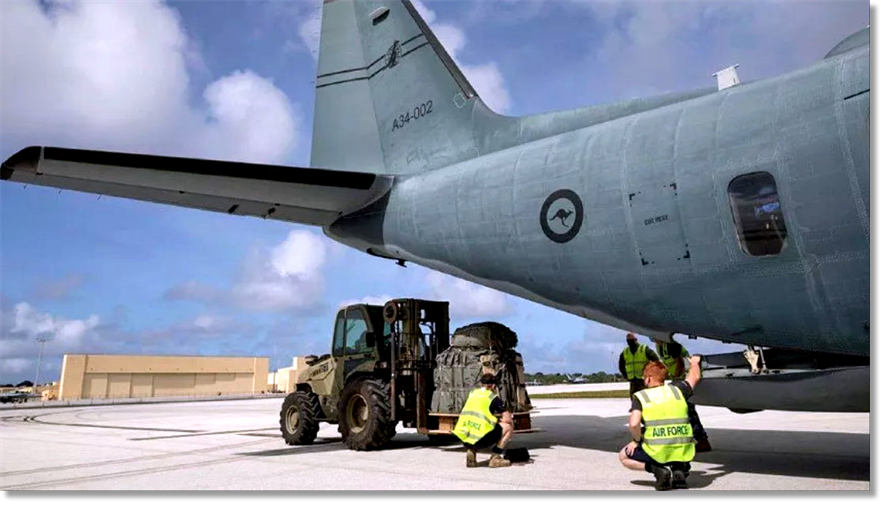
Defence has accepted a request for assistance from the Solomon Islands government, deploying two Royal Australian Air Force C-27J Spartan cargo aircraft carrying medical equipment and other essential supplies for provinces hit with a surge in COVID-19 cases. The support is expected to include the distribution of personal protective equipment (PPE) for health workers and emergency food aid to communities most impacted by the pandemic.
Additionally, six Australian-supplied ‘bricks’ of medical equipment and consumables will be distributed in provincial hospitals. The 15 cubic metre “bricks”, assembled in Brisbane, contain oxygen equipment and consumables, medication and PPE.
This latest commitment follows the deployment of an Australian Medical Assistance Team (AUSMAT) to the Solomon Islands last month, which is working in partnership with Health officials in Honiara. The Commonwealth government’s combined support to the Solomon Islands has included the provision of 300,800 AstraZeneca vaccine doses, and 19 tonnes of emergency medical supplies – including 100 oxygen concentrators.
This is the ADF’s latest regional support mission, with the military also assisting with the supply of humanitarian aid to Tonga following the eruption of the Hunga Tonga-Hunga-Ha'apai volcano and subsequent tsunami. Australia’s support for Tonga was recently broadened to include the restoration of power and communications, the storage and effective delivery of relief supplies, and further recovery efforts on the outer islands most affected.
defenceconnect.com.au
Additionally, six Australian-supplied ‘bricks’ of medical equipment and consumables will be distributed in provincial hospitals. The 15 cubic metre “bricks”, assembled in Brisbane, contain oxygen equipment and consumables, medication and PPE.
This latest commitment follows the deployment of an Australian Medical Assistance Team (AUSMAT) to the Solomon Islands last month, which is working in partnership with Health officials in Honiara. The Commonwealth government’s combined support to the Solomon Islands has included the provision of 300,800 AstraZeneca vaccine doses, and 19 tonnes of emergency medical supplies – including 100 oxygen concentrators.
This is the ADF’s latest regional support mission, with the military also assisting with the supply of humanitarian aid to Tonga following the eruption of the Hunga Tonga-Hunga-Ha'apai volcano and subsequent tsunami. Australia’s support for Tonga was recently broadened to include the restoration of power and communications, the storage and effective delivery of relief supplies, and further recovery efforts on the outer islands most affected.
defenceconnect.com.au

From: Barry Tappenden, Shortstown, Beds
Subject: The Trim Sheet
Good afternoon Tony,
Trim sheets - love them or hate them! I recall many years ago, in Singapore, FEAF MAMS, detached to Changi Movements, that I got lumbered with filling out a trim sheet for a Hastings aircraft.
Everything seemed very straightforward; 20 Army bods being moved from Changi to Labuan. All their kit stowed neatly towards the rear, trim looked perfect until the Army arrived They had been driven directly to the aircraft, no check-in. Each man was carrying in access of another 25 lbs of kit including weapons.
After a few adjustments to the trim and “ordering” the pax where to sit, and an AQM (with Captain) pulling their hair out to meet take-off time we successfully got the aircraft away on time (just). A lesson learned!
Kind regards
Barry
Subject: The Trim Sheet
Good afternoon Tony,
Trim sheets - love them or hate them! I recall many years ago, in Singapore, FEAF MAMS, detached to Changi Movements, that I got lumbered with filling out a trim sheet for a Hastings aircraft.
Everything seemed very straightforward; 20 Army bods being moved from Changi to Labuan. All their kit stowed neatly towards the rear, trim looked perfect until the Army arrived They had been driven directly to the aircraft, no check-in. Each man was carrying in access of another 25 lbs of kit including weapons.
After a few adjustments to the trim and “ordering” the pax where to sit, and an AQM (with Captain) pulling their hair out to meet take-off time we successfully got the aircraft away on time (just). A lesson learned!
Kind regards
Barry
The cargo aircraft have been sent to the Pacific island nation to assist with the COVID-19 response effort.
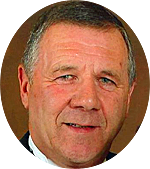

From: Tony Street, Buffalo, NY
Subject: Trim Sheets
Hi Tony,
I can remember the time when us Loadies had to use moment tables while calculating trim sheets. As Barbie told us, "Math is hard.”
Back in the day, I was a student at 4(T) out at RCAF Stn., Trenton, Ontario, and remember the Weight & Balance classes with mixed emotions. When most of us were laboring tearfully with weight and arms that created masses of moments, I was sinfully jealous of those with math skills. Just as we were at the point of dividing very long numbers by relatively smaller long numbers to arrive at some desired number, some math wizard would shout out the answer. If you didn’t have the same answer, you knew you were wrong. Cursing ensued. (I still remember his name, his Initials were Bill Clarke).
It's been ~60 years but I can still remember that the MAC or Mean Aerodynamic Chord: “Is the chord of a section of an imaginary airfoil surface having force vectors identical to that of a wing or wings.” (I think).
Then came the break! We discovered the first hand-held calculators in “Honkers”. We bought them in numbers for about $15 and sold them back home for $25; a king’s ransom in those days. We were initially forbidden to use them as it was believed they were not accurate and just a fad.
Subject: Trim Sheets
Hi Tony,
I can remember the time when us Loadies had to use moment tables while calculating trim sheets. As Barbie told us, "Math is hard.”
Back in the day, I was a student at 4(T) out at RCAF Stn., Trenton, Ontario, and remember the Weight & Balance classes with mixed emotions. When most of us were laboring tearfully with weight and arms that created masses of moments, I was sinfully jealous of those with math skills. Just as we were at the point of dividing very long numbers by relatively smaller long numbers to arrive at some desired number, some math wizard would shout out the answer. If you didn’t have the same answer, you knew you were wrong. Cursing ensued. (I still remember his name, his Initials were Bill Clarke).
It's been ~60 years but I can still remember that the MAC or Mean Aerodynamic Chord: “Is the chord of a section of an imaginary airfoil surface having force vectors identical to that of a wing or wings.” (I think).
Then came the break! We discovered the first hand-held calculators in “Honkers”. We bought them in numbers for about $15 and sold them back home for $25; a king’s ransom in those days. We were initially forbidden to use them as it was believed they were not accurate and just a fad.
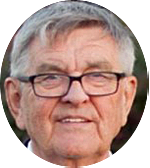

From: Steve Broadhurst, Brighton East, VIC
Subject: Trim Sheets
Tony,
I think the most important trimsheet I ever produced was for HM Queen Elizabeth II. It was for a VC10 flight that didn’t go anywhere, but was parked on the VIP bay in front of Brize Norton operations and served as the continuity theme for her trip. I think it was 1971 at a guess, early in the year, perhaps March or April.
I started that trim sheet in January of that year when a Flight Lieutenant turned up in Load Control to tell me I had been earmarked as the trim clerk to Royalty and needed to turn up the following day in my best blue, shirt, tie, cap and shoes. On doing so was promptly told to get them all replaced! The biggest task was to “write down what you do here and demonstrate it using a VC10 trim sheet".
That was January. Some time (weeks, months, it’s all a blur now) this Flt Lt had taken my 2+ pages of romantic crap about how I/we trim clerks compiled the data and plotted the C of G (naughty, no argot to be used) and the tailplane angle and precised it into 4 or 5 bullet points on a piece of adlister card (he had to have come from supply somewhere). “Practice this," he said, and I did, complete with sweeping hand motions to highlight where on the trimsheet I was focusing. You all know; basic weight, role tables, zero fuel weight, fuel load, APS weight, payload weight and distribution, standard pax layout, bags, freight and mail, all-up weight, then the plot.
I near wore out that new best blue so often I had to wear it for comment and approval. My hair was NOT allowed to grow one iota and my shoes were just never shiny enough!
As those who know where Load Control was in the Ops Centre will remember just how close to the OC Movements it was (cleaning his office at night was one of our tasks before any downtime).
So, the day arrived and HM duly showed up (red hat & coat as I remember) and round and round she went visiting the various parts of the station. When she finally showed up in the Ops Centre I thought there was more scrambled eggs present than a field kitchen at 06:30 am. My heart was pumping faster than when I first jumped from a DeHavilland Rapide of the RAFSPA over Weston-on-the-Green at 8,000 feet. Don’t pull this, or pull it wrong and you’re going to die. Focus boy, focus!
Well, I met her, shook her hand, if you can believe, and did my thing! It was the fastest 2 minutes of my life and the Wg.Cdr got his OBE and I got to go to Gan. We were both happy at that!
Steve Broadhurst
Kilo & Echo Teams
Abingdon & Lyneham, so long ago…
Subject: Trim Sheets
Tony,
I think the most important trimsheet I ever produced was for HM Queen Elizabeth II. It was for a VC10 flight that didn’t go anywhere, but was parked on the VIP bay in front of Brize Norton operations and served as the continuity theme for her trip. I think it was 1971 at a guess, early in the year, perhaps March or April.
I started that trim sheet in January of that year when a Flight Lieutenant turned up in Load Control to tell me I had been earmarked as the trim clerk to Royalty and needed to turn up the following day in my best blue, shirt, tie, cap and shoes. On doing so was promptly told to get them all replaced! The biggest task was to “write down what you do here and demonstrate it using a VC10 trim sheet".
That was January. Some time (weeks, months, it’s all a blur now) this Flt Lt had taken my 2+ pages of romantic crap about how I/we trim clerks compiled the data and plotted the C of G (naughty, no argot to be used) and the tailplane angle and precised it into 4 or 5 bullet points on a piece of adlister card (he had to have come from supply somewhere). “Practice this," he said, and I did, complete with sweeping hand motions to highlight where on the trimsheet I was focusing. You all know; basic weight, role tables, zero fuel weight, fuel load, APS weight, payload weight and distribution, standard pax layout, bags, freight and mail, all-up weight, then the plot.
I near wore out that new best blue so often I had to wear it for comment and approval. My hair was NOT allowed to grow one iota and my shoes were just never shiny enough!
As those who know where Load Control was in the Ops Centre will remember just how close to the OC Movements it was (cleaning his office at night was one of our tasks before any downtime).
So, the day arrived and HM duly showed up (red hat & coat as I remember) and round and round she went visiting the various parts of the station. When she finally showed up in the Ops Centre I thought there was more scrambled eggs present than a field kitchen at 06:30 am. My heart was pumping faster than when I first jumped from a DeHavilland Rapide of the RAFSPA over Weston-on-the-Green at 8,000 feet. Don’t pull this, or pull it wrong and you’re going to die. Focus boy, focus!
Well, I met her, shook her hand, if you can believe, and did my thing! It was the fastest 2 minutes of my life and the Wg.Cdr got his OBE and I got to go to Gan. We were both happy at that!
Steve Broadhurst
Kilo & Echo Teams
Abingdon & Lyneham, so long ago…
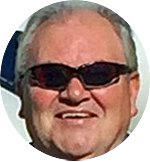

From: Budgie Baigent, Takaka, Tasman
Subject: The Trim Sheet
Tony,
I'm a bit rusty on the finer details, but a lesson I'll never forget happened at McMurdo Station, Antarctica, back in 1982. A self-propelled tracked drilling rig [a very heavy bit of kit] needed moving from McMurdo to Christchurch on a Kiwi Air Force C130. The airlift was notified late in the day with the aircraft due to depart early the next morning. The rig was still in the field and would not be available for preparation until very late at night so I directed the Army movers on night shift to weigh, prepare and position the rig on the Ice runway ready for loading and have the weights, dimensions, C of G, manifests, etc., on my desk first thing in the morning. I duly completed the trim sheet and monitored the loading and tying down, with the rig's C of G nicely positioned aft of the main spar.
The aircraft departed and I thought 'job well done' but later, after the aircraft had landed in Christchurch I received a priority message from their Operations Centre. The aircraft Captain had noticed a distinct tail-heavy attitude on departure and upon reaching cruise altitude the 'auto pilot' kept disengaging resulting in the aircraft being manually flown the entire route. Subsequent investigation and a re-weigh of the drill rig confirmed it had been weighed in KILOGRAMS but presented to me in POUNDS. Thanks to the very forgiving C130 an accident was averted but I certainly learned from that!
On a lighter note - how about NO trim sheet! I was the MOVCON working in Iraq post the Gulf War [UNSCOM] and my first airlift was a rather 'tight' load by a Civil UN chartered C130. I prepared a load plan and on arrival of the aircraft at Habbaniya [IRAQ Air Force Base] I presented the load plan to the loadmaster. "We never use those" he said. "So what documents do you use to prepare the trim" I ask. "We don't use those either" he said. "Just give me the total weight and I'll give you the sequence. Once loaded, I'll check the nose wheel to make sure it's within limits". Blew me away!
Soon afterwards I checked the flight deck and sure enough, tucked away was a large pad of 'unused' trim sheets - I guess the 'front enders' just relied on the payload figure for their calculations while the loadmaster was in charge of the nose wheel lol. [As it happened the sequence was unchanged from what I had prepared].
Cheers, Budgie
Subject: The Trim Sheet
Tony,
I'm a bit rusty on the finer details, but a lesson I'll never forget happened at McMurdo Station, Antarctica, back in 1982. A self-propelled tracked drilling rig [a very heavy bit of kit] needed moving from McMurdo to Christchurch on a Kiwi Air Force C130. The airlift was notified late in the day with the aircraft due to depart early the next morning. The rig was still in the field and would not be available for preparation until very late at night so I directed the Army movers on night shift to weigh, prepare and position the rig on the Ice runway ready for loading and have the weights, dimensions, C of G, manifests, etc., on my desk first thing in the morning. I duly completed the trim sheet and monitored the loading and tying down, with the rig's C of G nicely positioned aft of the main spar.
The aircraft departed and I thought 'job well done' but later, after the aircraft had landed in Christchurch I received a priority message from their Operations Centre. The aircraft Captain had noticed a distinct tail-heavy attitude on departure and upon reaching cruise altitude the 'auto pilot' kept disengaging resulting in the aircraft being manually flown the entire route. Subsequent investigation and a re-weigh of the drill rig confirmed it had been weighed in KILOGRAMS but presented to me in POUNDS. Thanks to the very forgiving C130 an accident was averted but I certainly learned from that!
On a lighter note - how about NO trim sheet! I was the MOVCON working in Iraq post the Gulf War [UNSCOM] and my first airlift was a rather 'tight' load by a Civil UN chartered C130. I prepared a load plan and on arrival of the aircraft at Habbaniya [IRAQ Air Force Base] I presented the load plan to the loadmaster. "We never use those" he said. "So what documents do you use to prepare the trim" I ask. "We don't use those either" he said. "Just give me the total weight and I'll give you the sequence. Once loaded, I'll check the nose wheel to make sure it's within limits". Blew me away!
Soon afterwards I checked the flight deck and sure enough, tucked away was a large pad of 'unused' trim sheets - I guess the 'front enders' just relied on the payload figure for their calculations while the loadmaster was in charge of the nose wheel lol. [As it happened the sequence was unchanged from what I had prepared].
Cheers, Budgie


From: Fred Martin, Godalming, Surrey
Subject: Trim Sheets
Hi Tony, great story about the trim sheet, here’s my two-penny worth.
Arriving at Khormaksar in August 1961 straight from the Movements School, for some reason I was put straight into Load Control and stayed there for the best part of two years. Khormaksar was the busiest RAF station on the planet and certainly the workload of Air Movements was increasing dramatically and continued to do so all of my tour.
We had to trim all the "local flights" i.e. the up-country Beverleys and Valettas and latterly Argosys. The Beverleys also ran a service down to Nairobi. On top of this we had the QTR’s (mostly Britannias but also some Comets) which staged through Aden on the Lyneham/El Adem/ Aden/ Gan / Singapore route. The trim sheets on these had to be done very quickly as the aircraft were only on the ground a short time and with freight and pax going on and off we had to work quickly. Usually there were just two of us doing the trim sheets, but we always managed somehow.
I never heard of any disasters due to incorrect trim ,so we must have done our work reasonably well!
Best wishes,
Fred
Subject: Trim Sheets
Hi Tony, great story about the trim sheet, here’s my two-penny worth.
Arriving at Khormaksar in August 1961 straight from the Movements School, for some reason I was put straight into Load Control and stayed there for the best part of two years. Khormaksar was the busiest RAF station on the planet and certainly the workload of Air Movements was increasing dramatically and continued to do so all of my tour.
We had to trim all the "local flights" i.e. the up-country Beverleys and Valettas and latterly Argosys. The Beverleys also ran a service down to Nairobi. On top of this we had the QTR’s (mostly Britannias but also some Comets) which staged through Aden on the Lyneham/El Adem/ Aden/ Gan / Singapore route. The trim sheets on these had to be done very quickly as the aircraft were only on the ground a short time and with freight and pax going on and off we had to work quickly. Usually there were just two of us doing the trim sheets, but we always managed somehow.
I never heard of any disasters due to incorrect trim ,so we must have done our work reasonably well!
Best wishes,
Fred


UK confirms intent to acquire additional A400M airlifters
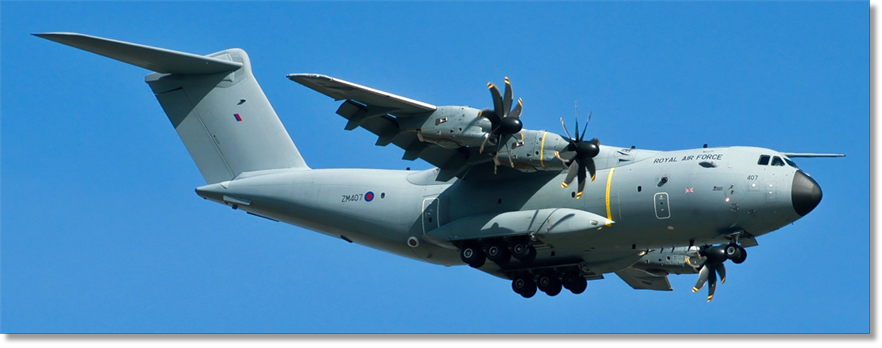
With 22 A400Ms currently on order, deliveries of which are almost complete, the UK intends to buy an undisclosed number of additional airframes in future years to add mass to its fixed-wing air mobility force. The United Kingdom has firmed up its intent to acquire additional Airbus A400M Atlas airlifters, with the procurement featuring in the latest Defence Equipment Plan 2021–2031.
In the plan published on 21 February, the Ministry of Defence (MoD) made several references to its decision to acquire further A400M aircraft to add to the 22 currently on order, although the proposed additional aircraft numbers, budgets, and timelines were not disclosed. “In later years of the plan, [there will be] planned equipment investments worth GBP2.3 billion [USD3.13 billion], including […] further A400M aircraft,” the plan noted. It added that the top-level budget for this and other longer-term items has not yet been delegated, “and doing so will be dependent on the affordability of the programme as a whole”.
The Royal Air Force (RAF) has to date received 20 of its 22 A400Ms, with the last two scheduled to be handed over shortly. The medium-lift aircraft provides the service's mid-tier airlift capability, with its 37 tonnes payload capacity sitting in-between the 22 tonnes of the Lockheed Martin C-130J Hercules and the 72 tonnes of the Boeing C-17A Globemaster III.
janes.com
In the plan published on 21 February, the Ministry of Defence (MoD) made several references to its decision to acquire further A400M aircraft to add to the 22 currently on order, although the proposed additional aircraft numbers, budgets, and timelines were not disclosed. “In later years of the plan, [there will be] planned equipment investments worth GBP2.3 billion [USD3.13 billion], including […] further A400M aircraft,” the plan noted. It added that the top-level budget for this and other longer-term items has not yet been delegated, “and doing so will be dependent on the affordability of the programme as a whole”.
The Royal Air Force (RAF) has to date received 20 of its 22 A400Ms, with the last two scheduled to be handed over shortly. The medium-lift aircraft provides the service's mid-tier airlift capability, with its 37 tonnes payload capacity sitting in-between the 22 tonnes of the Lockheed Martin C-130J Hercules and the 72 tonnes of the Boeing C-17A Globemaster III.
janes.com
From: David Bernard, Bicester, Oxon
Subject: Trim Sheets
Hello Tony,
I had endured blanket-stacking appointments at Hereford, Finningley, Malta and Lyneham and had become bored witless with endless voucher scrutiny - and a pain in the butt with my appointer, continually whining for a movements appointment over the years. In due course I passed out from the movements school and was posted 200 yards away to the movements squadron at Brize, starting as a duty passenger officer – DPaxO then DAMO (D shift). Then in March ’74 posted to load control/movements ops. Within a couple of months, I and a Britannia loadmaster, Ralph (Geordie) Dexter from 511 Squadron (Britannias), were co-opted to join the Simplification of Documentation Committee, fondly known as the SOD Committee, at Upavon (pronounced ‘yoo-pa-von’ by our US cousins) – then designated as the headquarters of 46 Group.
The amalgamation of exercise and operational manifests for pax, freight and air waybills were an easy fix but the more challenging remit from the chairman, group captain strategic ops was to standardise and simplify all trim sheets used throughout the RAF ATF. You will remember that the trim sheets used in those days were printed in red on white paper and varied in sizes ranging from A2 (420mm X 594mm) and A3 (297mm X 420mm). As you will recall, load data by weight and location was recorded on the trim sheet translated into a “herringbone” matrix, which eventually made its way into an “envelope” to indicate where the effect of load distribution had on the aircraft trim. In the case of the VC10 the trim sheet was used to change the TPI - tail position indicator.
The existing trim sheets were large and difficult to stow while the “herringbone” graph was inaccurate and dependent upon the thickness of the pen used to mark it, the quality of the trim clerk or loadmasters’ eyesight and the lighting available. On the Belfast trim the individual “herringbone” widths for each load section were unequal, up to 1mm along the same line, while the VC10 trim sheets had no instructions at all on the reverse. A visit to the drawing loft at BAC Weybridge revealed that the VC10 trim sheet was only completed in draft form and was removed from the draftsman’s desk, printed by HMSO, and distributed before it was completed!
Subject: Trim Sheets
Hello Tony,
I had endured blanket-stacking appointments at Hereford, Finningley, Malta and Lyneham and had become bored witless with endless voucher scrutiny - and a pain in the butt with my appointer, continually whining for a movements appointment over the years. In due course I passed out from the movements school and was posted 200 yards away to the movements squadron at Brize, starting as a duty passenger officer – DPaxO then DAMO (D shift). Then in March ’74 posted to load control/movements ops. Within a couple of months, I and a Britannia loadmaster, Ralph (Geordie) Dexter from 511 Squadron (Britannias), were co-opted to join the Simplification of Documentation Committee, fondly known as the SOD Committee, at Upavon (pronounced ‘yoo-pa-von’ by our US cousins) – then designated as the headquarters of 46 Group.
The amalgamation of exercise and operational manifests for pax, freight and air waybills were an easy fix but the more challenging remit from the chairman, group captain strategic ops was to standardise and simplify all trim sheets used throughout the RAF ATF. You will remember that the trim sheets used in those days were printed in red on white paper and varied in sizes ranging from A2 (420mm X 594mm) and A3 (297mm X 420mm). As you will recall, load data by weight and location was recorded on the trim sheet translated into a “herringbone” matrix, which eventually made its way into an “envelope” to indicate where the effect of load distribution had on the aircraft trim. In the case of the VC10 the trim sheet was used to change the TPI - tail position indicator.
The existing trim sheets were large and difficult to stow while the “herringbone” graph was inaccurate and dependent upon the thickness of the pen used to mark it, the quality of the trim clerk or loadmasters’ eyesight and the lighting available. On the Belfast trim the individual “herringbone” widths for each load section were unequal, up to 1mm along the same line, while the VC10 trim sheets had no instructions at all on the reverse. A visit to the drawing loft at BAC Weybridge revealed that the VC10 trim sheet was only completed in draft form and was removed from the draftsman’s desk, printed by HMSO, and distributed before it was completed!
(Click on the image to see the original full-sized Belfast trim sheet)

Following consultation with the operational squadrons, the OCU, JATE, the aircraft manufacturers and the Movements School, and the following criteria were identified. The trim sheets should all be:
•
Reduced to A4 size paper in a standardised format for all AT aircraft types operating in any role.
•
Be printed on paper and print colour, which showed best under any conditions, especially flight deck lighting at night.
•
Use a simplified mathematical method of recording index changes in place of the inaccurate “herringbone” method.
•
The documents should be designed to reduce completion time to a minimum without prejudice to trim accuracy by ensuring that any mathematical calculations are simple and within the capabilities of aircrew and movements staff.
Geordie and I visited commercial airline training and operational areas; aerospace manufacturers, RAF operational squadrons, OCUs and the Movements School. We managed to co-opt an education officer at Brize; one Jim Alford who agreed to act as draftsman and mathematician. We were also fortunate in having a sizeable printing section on the station and a very helpful print operator.
It took us 6 weeks to devise and produce the final trim sheet drafts, standardised for C130, Britannia, VC10 and Belfast aircraft. We experimented with some 45 paper and print colour combinations. We chose the best compatibility under night time cockpit lighting conditions using red ink on a pastel green paper. These were distributed, in pads of 60 A4 sheets.
Most importantly we adopted a method of calculating weight and balance results quickly, especially at QTR operations at staging posts. The load compartments for the VC10 were reduced from19 to just 6 main compartments and 4 lower hold areas. All these changes were made following consultation with the aircraft manufacturer weight and balance departments.
I never thought that I would ever use algebra after I left school – especially being mathematically dyslexic! However, with the advice of our tame educator, Jim Alford, algebra was the basis for compiling these new trim sheets.
Our reward for delivering these new trim sheets was a remit to travel worldwide and train all aircrew and movements staff after which a 6-month trial would begin. The rest is history and standardised A4 size trim sheets, with no “herringbone” graphics were adopted. Examples of the original, revised trim sheets are attached.
It took us 6 weeks to devise and produce the final trim sheet drafts, standardised for C130, Britannia, VC10 and Belfast aircraft. We experimented with some 45 paper and print colour combinations. We chose the best compatibility under night time cockpit lighting conditions using red ink on a pastel green paper. These were distributed, in pads of 60 A4 sheets.
Most importantly we adopted a method of calculating weight and balance results quickly, especially at QTR operations at staging posts. The load compartments for the VC10 were reduced from19 to just 6 main compartments and 4 lower hold areas. All these changes were made following consultation with the aircraft manufacturer weight and balance departments.
I never thought that I would ever use algebra after I left school – especially being mathematically dyslexic! However, with the advice of our tame educator, Jim Alford, algebra was the basis for compiling these new trim sheets.
Our reward for delivering these new trim sheets was a remit to travel worldwide and train all aircrew and movements staff after which a 6-month trial would begin. The rest is history and standardised A4 size trim sheets, with no “herringbone” graphics were adopted. Examples of the original, revised trim sheets are attached.
From: Alex Masson, Tunbridge Wells, Kent
Subject: The Trim Sheet
Hello Tony,
Yes, I remember the Trim Sheet very well! - Even before the Trim Sheet – where we had to calculate the datum point in the nose of the aircraft, to the hold where we were putting the load in, and multiply it to get the moments. This had to be done in every hold, including the crew quarters. Then divide them out to get the mean average, which had to be within two inches of the centre of gravity (I think) of the aircraft.
I first went to Lyneham 13th of April 1955, after my initial training. I wound up in inward freight, on B shift. This was the least busy section, and I spent the remainder of my time helping outward freight or loading party. There was one young airman, Alan Geffen who was unable, physically, to lift a box, but I discovered he was a maths wizard. So, I had a word with our Corporal Jack Wilson, and he was moved to load control. Now we had on B shift our own ‘maths wizard'. He taught me a thing or two about the Trim Sheet that was now coming in to use. No movements school in those days for me, we had to learn on the job.
Before we went to Christmas Island, my friend Corporal Philip Pratley and I were put on a parachute dropping course by 47 Company, RASC (the Army) which lasted from September to October 1956.
Towards the end of the first week, one afternoon was to be a lecture by the CO, who was a captain whose name I cannot now recall. He commenced by explaining that this lecture was most important, and went on to describe the weight and balance of the cargo aeroplane, in this case the Hastings. He correctly drew our attention to the restrictive limits of the permissible centre of gravity of the aircraft, which changes according to where the load is variously placed, and how it had to remain within these limits throughout take-off, flight and ultimately the landing condition.
While this was intriguing stuff for some students, others, judging by the blank looks on some faces, clearly were completely baffled. To us, however, it was second nature as we had been loading these aeroplanes for almost two years.
I suppose I was getting a little bored with this as he wasn’t teaching us anything we did not know. My mind wandered and I was elsewhere when suddenly I was brought down to earth by something the captain said. He was going through the mathematics of this aircraft load, putting a Landrover hard up front in a Hastings with some kind of small field gun up behind it with the trail of the gun snugly placed under the Landrover. I made a quick calculation and leaned over to Phil, who had been a little more awake than me, for he was scribbling furiously and he pre-empted me by saying, “Yes, it’s nose heavy!” I remarked “His figures are wrong.”
Subject: The Trim Sheet
Hello Tony,
Yes, I remember the Trim Sheet very well! - Even before the Trim Sheet – where we had to calculate the datum point in the nose of the aircraft, to the hold where we were putting the load in, and multiply it to get the moments. This had to be done in every hold, including the crew quarters. Then divide them out to get the mean average, which had to be within two inches of the centre of gravity (I think) of the aircraft.
I first went to Lyneham 13th of April 1955, after my initial training. I wound up in inward freight, on B shift. This was the least busy section, and I spent the remainder of my time helping outward freight or loading party. There was one young airman, Alan Geffen who was unable, physically, to lift a box, but I discovered he was a maths wizard. So, I had a word with our Corporal Jack Wilson, and he was moved to load control. Now we had on B shift our own ‘maths wizard'. He taught me a thing or two about the Trim Sheet that was now coming in to use. No movements school in those days for me, we had to learn on the job.
Before we went to Christmas Island, my friend Corporal Philip Pratley and I were put on a parachute dropping course by 47 Company, RASC (the Army) which lasted from September to October 1956.
Towards the end of the first week, one afternoon was to be a lecture by the CO, who was a captain whose name I cannot now recall. He commenced by explaining that this lecture was most important, and went on to describe the weight and balance of the cargo aeroplane, in this case the Hastings. He correctly drew our attention to the restrictive limits of the permissible centre of gravity of the aircraft, which changes according to where the load is variously placed, and how it had to remain within these limits throughout take-off, flight and ultimately the landing condition.
While this was intriguing stuff for some students, others, judging by the blank looks on some faces, clearly were completely baffled. To us, however, it was second nature as we had been loading these aeroplanes for almost two years.
I suppose I was getting a little bored with this as he wasn’t teaching us anything we did not know. My mind wandered and I was elsewhere when suddenly I was brought down to earth by something the captain said. He was going through the mathematics of this aircraft load, putting a Landrover hard up front in a Hastings with some kind of small field gun up behind it with the trail of the gun snugly placed under the Landrover. I made a quick calculation and leaned over to Phil, who had been a little more awake than me, for he was scribbling furiously and he pre-empted me by saying, “Yes, it’s nose heavy!” I remarked “His figures are wrong.”

Next thing, I was aware of the captain bellowing at us telling us to be quiet and that he would not tolerate any talking or interruptions of his lecture. Before he had finished, I said, “Just a cotton-picking minute! Is that the entire load for that aircraft?”
“Yes!” he snapped.
I continued, “Then you are doing something wrong!”
The Captain went into a rage. “Don’t tell me I’m wrong. I have here the official instructions ….”
I interrupted him again saying, “I don’t know what you have there, but we load these planes every day of our working life and can see that something is badly wrong! If that is all the load then, the plane will be nose heavy and well out of trim.”
Phil joined me, adding, “He’s right sir! That plane will be nose heavy but at this moment I can’t for the life of me, see why.”
We both returned to scribbling our calculations furiously. I could see the captain was not impressed by our interruption so I took a gamble saying, “Have you actually loaded and completed the weight and balance trim sheet for one of these aeroplanes?”
The captain went very quiet. Then said, “Well actually, no. Good God! You’re serious! What exactly is wrong?”
Phil held up his hand as if to stop him, saying, “We don’t know … but something is!”
The captain then said, “OK, the rest of you, go for a NAAFI break and don’t come back until you’re called for. You RAF chaps come up here and we’ll find out what’s gone wrong.”
Gathering around the table, the captain commenced, “Let’s start at the beginning, the basic empty weight of the Hastings is 41,689 lbs plus crew and standard equipment at 4,470 lbs gives us 46,159 lbs before load or fuel ….”
We both broke in with “No way! Before fuel and load, Hastings are between 53 and 54,000 lbs.” Then I saw on the top of the form Hastings Mk1. I said, “Good grief! There are no Mark 1’s flying in the RAF. They are all Mark 2’s or 1A’s."
We then explained that there were no Mk1 aircraft in RAF Squadron service any more, they were all now modified up to Mk2 standard with bigger, heavier and more powerful engines. They had been re-designated Mk1A aircraft. This had altered the C of G limits. No wonder his calculations were wrong.
“Yes!” he snapped.
I continued, “Then you are doing something wrong!”
The Captain went into a rage. “Don’t tell me I’m wrong. I have here the official instructions ….”
I interrupted him again saying, “I don’t know what you have there, but we load these planes every day of our working life and can see that something is badly wrong! If that is all the load then, the plane will be nose heavy and well out of trim.”
Phil joined me, adding, “He’s right sir! That plane will be nose heavy but at this moment I can’t for the life of me, see why.”
We both returned to scribbling our calculations furiously. I could see the captain was not impressed by our interruption so I took a gamble saying, “Have you actually loaded and completed the weight and balance trim sheet for one of these aeroplanes?”
The captain went very quiet. Then said, “Well actually, no. Good God! You’re serious! What exactly is wrong?”
Phil held up his hand as if to stop him, saying, “We don’t know … but something is!”
The captain then said, “OK, the rest of you, go for a NAAFI break and don’t come back until you’re called for. You RAF chaps come up here and we’ll find out what’s gone wrong.”
Gathering around the table, the captain commenced, “Let’s start at the beginning, the basic empty weight of the Hastings is 41,689 lbs plus crew and standard equipment at 4,470 lbs gives us 46,159 lbs before load or fuel ….”
We both broke in with “No way! Before fuel and load, Hastings are between 53 and 54,000 lbs.” Then I saw on the top of the form Hastings Mk1. I said, “Good grief! There are no Mark 1’s flying in the RAF. They are all Mark 2’s or 1A’s."
We then explained that there were no Mk1 aircraft in RAF Squadron service any more, they were all now modified up to Mk2 standard with bigger, heavier and more powerful engines. They had been re-designated Mk1A aircraft. This had altered the C of G limits. No wonder his calculations were wrong.
The captain addressed us with, “I would like to express my appreciation to the RAF chaps here, who have drawn my attention to a fairly serious error. I would like to apologise for bawling at them for interrupting; I am more than pleased that they did. We have been instructing on an obsolete aircraft and we have never been updated as to what the RAF are currently using. Signals are at this very moment going out to all trained staff to be aware of this fact, and arrangements are in hand for a re-training programme for all personnel to be initiated.”
The captain, was greatly appreciative of our intervention, and spent a long time talking with us and finding out exactly what our job was in the RAF. For the remainder of the course we were consulted on all manner of procedures, just in case there were any other quirks in loading aeroplanes which could affect the efficiency of the training programme of 47 Company RASC.
Fast forward to the 8th December 1956 – when I was posted to Christmas Island. – The SAMO was Flight Lieutenant John Donald Hepton and he had three sergeants! Could you believe it? - THREE SERGEANTS! and me, an SAC. These sergeants would not lift a box – they told me they were here to supervise!
I do not believe that they had ever seen an aeroplane in their lives before! And for that matter, neither had the Flight Lieutenant! You may be aware that air movements was a branch of the stores trade – Supplier II – the other roles were road, rail and sea movements. But air movements was a different ‘kettle of fish’! We were expected to load the aeroplane and complete the weight and balance of the aircraft. These three sergeants were storemen proper, and did not have the specialist knowledge required. They were useless to me!
I do not know what the sergeants were doing before I arrived, they had to rely on an ops clerk, John Aydon, for support. As soon as I arrived, he relinquished his duties and reverted to being an ops clerk in the control tower.
So, I began to train the sergeants up to do the weight and balance. One sergeant, Paddy Byrne, took to the weight and balance and he showed a keen interest in it. The other two were not really interested. So, I left Paddy to do what he was good at. That was fine by me, my maths had never been that good, so I let him get on with it. He did me a real favour by allowing him to complete the weight and balance. I told him what I wanted, to put the freight/passengers in each hold, and he did the trim sheet. Like you Tony, I was no mathematician, I had difficulty in adding up my darts score! That is how bad it was!
Eventually, I was given my loading party on the first week in February 1957. They were general duties airmen, they were not trained in anything specific, and had been employed on the ‘honey wagon’, that is to say, that they emptied the latrines. I had requested for a four-man team. I now had LAC Hall as my assistant, but I didn’t mind that, the more the merrier. On Tuesday 22 January 1957 I was made Corporal. And within the month, I was made substantive, back to the 22 January. This was unusual, for some people they were never substantive. Most people took at least six months in the rank to be confirmed.
I often think, in hindsight, my CO, Don Hepton, could’ve had a hand in this. You see he could never rely upon the three sergeants, and I was the only one that had any experience in loading and unloading aircraft.
The captain, was greatly appreciative of our intervention, and spent a long time talking with us and finding out exactly what our job was in the RAF. For the remainder of the course we were consulted on all manner of procedures, just in case there were any other quirks in loading aeroplanes which could affect the efficiency of the training programme of 47 Company RASC.
Fast forward to the 8th December 1956 – when I was posted to Christmas Island. – The SAMO was Flight Lieutenant John Donald Hepton and he had three sergeants! Could you believe it? - THREE SERGEANTS! and me, an SAC. These sergeants would not lift a box – they told me they were here to supervise!
I do not believe that they had ever seen an aeroplane in their lives before! And for that matter, neither had the Flight Lieutenant! You may be aware that air movements was a branch of the stores trade – Supplier II – the other roles were road, rail and sea movements. But air movements was a different ‘kettle of fish’! We were expected to load the aeroplane and complete the weight and balance of the aircraft. These three sergeants were storemen proper, and did not have the specialist knowledge required. They were useless to me!
I do not know what the sergeants were doing before I arrived, they had to rely on an ops clerk, John Aydon, for support. As soon as I arrived, he relinquished his duties and reverted to being an ops clerk in the control tower.
So, I began to train the sergeants up to do the weight and balance. One sergeant, Paddy Byrne, took to the weight and balance and he showed a keen interest in it. The other two were not really interested. So, I left Paddy to do what he was good at. That was fine by me, my maths had never been that good, so I let him get on with it. He did me a real favour by allowing him to complete the weight and balance. I told him what I wanted, to put the freight/passengers in each hold, and he did the trim sheet. Like you Tony, I was no mathematician, I had difficulty in adding up my darts score! That is how bad it was!
Eventually, I was given my loading party on the first week in February 1957. They were general duties airmen, they were not trained in anything specific, and had been employed on the ‘honey wagon’, that is to say, that they emptied the latrines. I had requested for a four-man team. I now had LAC Hall as my assistant, but I didn’t mind that, the more the merrier. On Tuesday 22 January 1957 I was made Corporal. And within the month, I was made substantive, back to the 22 January. This was unusual, for some people they were never substantive. Most people took at least six months in the rank to be confirmed.
I often think, in hindsight, my CO, Don Hepton, could’ve had a hand in this. You see he could never rely upon the three sergeants, and I was the only one that had any experience in loading and unloading aircraft.
You may have had a message from Chris Hobson, chobson208@gmail.com He is writing a book on the Handley Page Hastings. I have been giving him some support, he was fascinated with the trim sheet. Chris was never in the Royal Air Force, although he always had a strong interest in aeroplanes, hence he is writing the book.
Remind me, I think that trim sheets were in triplicate, the red, one which accompanied the aircraft, white, the one that was sent to Upavon, the Headquarters of Transport Command, and the third copy was retained at the station where it was sent from. I seem to remember that it was blue.
But as time went by, I used to compete the Hastings and the Dakota Trim Sheets, and when I eventually returned to the UK and back to Lyneham, I was put in Load Control.
End of my story. Alex Masson. Cpl.
Remind me, I think that trim sheets were in triplicate, the red, one which accompanied the aircraft, white, the one that was sent to Upavon, the Headquarters of Transport Command, and the third copy was retained at the station where it was sent from. I seem to remember that it was blue.
But as time went by, I used to compete the Hastings and the Dakota Trim Sheets, and when I eventually returned to the UK and back to Lyneham, I was put in Load Control.
End of my story. Alex Masson. Cpl.
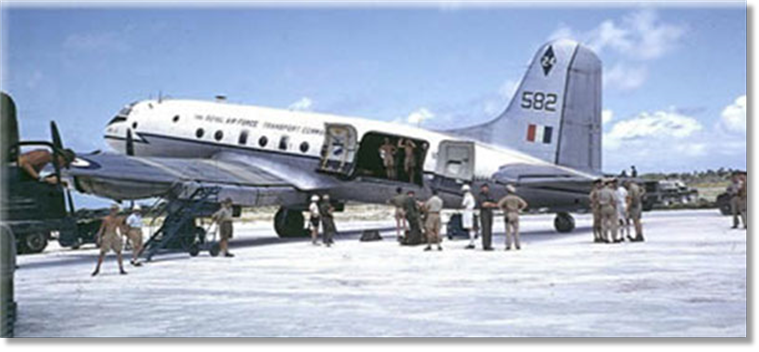
A Hastings on Christmas Island. Alex Masson is standing in the doorway with his arms up.

From: Keri "Taff" Eynon, Thatcham, Berks
Subject: The Trim Sheet
Hi Tony,
Apart from training and the odd helping out at busy times I did not get too heavily involved with trim sheets. However, that changed in Gutersloh when I suddenly found myself as trim clerk. At first it was pretty normal with mainly Herc trims to do with, at certain times, VC10's when troops were off to Calgary.
There were other flights chartered by PSI to provide cheap flights for families wishing to visit people in Germany. They normally used BAC 1-11's operaed by British Caledonian and, all of a sudden I was presented with their trim sheet to do. Fortunately with just a few minor differences these were pretty straightforward.
Then came the shock when I asked the DAMO to check and sign the completed sheet; I was politely informed that they did not do that. On asking the aircraft captain to check and sign it, I was informed that did not happen as it was the person who prepared the sheet who had to sign it. So for the rest of the time I, as an SAC trim clerk, prepared and signed numerous BAC1-11 trim sheets.
Cheers, Keri
Subject: The Trim Sheet
Hi Tony,
Apart from training and the odd helping out at busy times I did not get too heavily involved with trim sheets. However, that changed in Gutersloh when I suddenly found myself as trim clerk. At first it was pretty normal with mainly Herc trims to do with, at certain times, VC10's when troops were off to Calgary.
There were other flights chartered by PSI to provide cheap flights for families wishing to visit people in Germany. They normally used BAC 1-11's operaed by British Caledonian and, all of a sudden I was presented with their trim sheet to do. Fortunately with just a few minor differences these were pretty straightforward.
Then came the shock when I asked the DAMO to check and sign the completed sheet; I was politely informed that they did not do that. On asking the aircraft captain to check and sign it, I was informed that did not happen as it was the person who prepared the sheet who had to sign it. So for the rest of the time I, as an SAC trim clerk, prepared and signed numerous BAC1-11 trim sheets.
Cheers, Keri

From: Tony Last, Huntingdon, Cambs
Subject: The Trim Sheet
Hi Tony,
Inspired by the excellent introductory effort from our editor in announcing the topic for the next edition, I was prompted to have a think myself and conjure up a bit of nostalgia of my own. Throughout my Movers years, which included Base, Mobility and UKMAMS, I always seemed to be associated with the trim sheet in one way or another at most ranks. Having successfully negotiated my way through the likes of the Beverley, Argosy, VC10, Hercules, Belfast, Britannia, Hastings, Pembroke, Andovers, Comets 2 & 4, and various civilian stuff, such as the DC7 and the good old Ace Freighters Constellation aircraft trims, I think I had a good grounding in the subject. Then MMars (I think it was called) happened and trim sheets gradually disappeared, in their paper format anyway. I have no idea what happens today, as it's now some 30 years since I had the pleasure.
Like Tony said in his article, the first trim you ever do 'LIVE' gets checked so many times that it seems impossible that you could have made a mistake. Isn't it strange though how sometimes 2 + 2 makes 5 and you just don't spot it. My biggest whoops was trying to rewrite a Mk1 to a Mk3 Herc Trim, because I had knocked my coffee over the original. Dohhh! Fortunately I spotted my deliberate mistake and gave myself a good listening to. Pressure of work Guv'nor.
I enjoyed my time in Trims as it was something that rarely phased me, despite the different aircraft types and varied load combinations. I even gave a short presentation on trims and aircraft weight and balance at an interview for Instructor Duties (as a Flt Sgt) during my Co-ord days at Lyneham in the late 80's. Colin Allen was trying to get me on the staff at the School but I didn't want the job, but to help him out I agreed to do the presentation, which apparently went very well. Fortunately I knew of another F/Sgt who was dead keen to get the job so was able to fend it off. I picked up my Warrant within 12 months and I often wondered whether it would have still happened had I taken the instructor job.
Three other occasions immediately came to mind during my earlier days of trim sheet duties. Whilst at Khormaksar in Aden, in the 1966/67 era, and employed in the trim office on A Shift, with my old buddie Colin Allen, on one particular night one of our pan lads, SAC Jude Whittle, was killed when a 45-gallon oil drum fell on him from an unsecured pallet which had been balanced on forklift tines (pre-slave pallet days). They were loading a Beverley for the Zambian Oil Lift at the time.
The following morning, the AQM [Air Quarter Master - predecessor to the loadmaster] came in with attitude, to get his trim sheet, but I was running late, due to happenings during the night. He gave me, and all movers in general, a bit of abuse so I told him what had happened and invited him to go away sexually while I finished his sexual trim sheet. I have to say he was most apologetic afterwards and looked like he wished the ground could have opened up to swallow him. He eventually got his trim sheet and scuttled off but was as nice as pie whenever we saw him after that. I did get a raised eyebrow from the DAMO. Upsetting an AQM! Tsk! Tsk!
Subject: The Trim Sheet
Hi Tony,
Inspired by the excellent introductory effort from our editor in announcing the topic for the next edition, I was prompted to have a think myself and conjure up a bit of nostalgia of my own. Throughout my Movers years, which included Base, Mobility and UKMAMS, I always seemed to be associated with the trim sheet in one way or another at most ranks. Having successfully negotiated my way through the likes of the Beverley, Argosy, VC10, Hercules, Belfast, Britannia, Hastings, Pembroke, Andovers, Comets 2 & 4, and various civilian stuff, such as the DC7 and the good old Ace Freighters Constellation aircraft trims, I think I had a good grounding in the subject. Then MMars (I think it was called) happened and trim sheets gradually disappeared, in their paper format anyway. I have no idea what happens today, as it's now some 30 years since I had the pleasure.
Like Tony said in his article, the first trim you ever do 'LIVE' gets checked so many times that it seems impossible that you could have made a mistake. Isn't it strange though how sometimes 2 + 2 makes 5 and you just don't spot it. My biggest whoops was trying to rewrite a Mk1 to a Mk3 Herc Trim, because I had knocked my coffee over the original. Dohhh! Fortunately I spotted my deliberate mistake and gave myself a good listening to. Pressure of work Guv'nor.
I enjoyed my time in Trims as it was something that rarely phased me, despite the different aircraft types and varied load combinations. I even gave a short presentation on trims and aircraft weight and balance at an interview for Instructor Duties (as a Flt Sgt) during my Co-ord days at Lyneham in the late 80's. Colin Allen was trying to get me on the staff at the School but I didn't want the job, but to help him out I agreed to do the presentation, which apparently went very well. Fortunately I knew of another F/Sgt who was dead keen to get the job so was able to fend it off. I picked up my Warrant within 12 months and I often wondered whether it would have still happened had I taken the instructor job.
Three other occasions immediately came to mind during my earlier days of trim sheet duties. Whilst at Khormaksar in Aden, in the 1966/67 era, and employed in the trim office on A Shift, with my old buddie Colin Allen, on one particular night one of our pan lads, SAC Jude Whittle, was killed when a 45-gallon oil drum fell on him from an unsecured pallet which had been balanced on forklift tines (pre-slave pallet days). They were loading a Beverley for the Zambian Oil Lift at the time.
The following morning, the AQM [Air Quarter Master - predecessor to the loadmaster] came in with attitude, to get his trim sheet, but I was running late, due to happenings during the night. He gave me, and all movers in general, a bit of abuse so I told him what had happened and invited him to go away sexually while I finished his sexual trim sheet. I have to say he was most apologetic afterwards and looked like he wished the ground could have opened up to swallow him. He eventually got his trim sheet and scuttled off but was as nice as pie whenever we saw him after that. I did get a raised eyebrow from the DAMO. Upsetting an AQM! Tsk! Tsk!

On another Aden occasion, during the morning of our day shift, either the NLF (National Liberation Front) or FLOSY (Freedom for the Liberation of South Yemen), not sure which one, decided to fire mortars at the Khormaksar airfield. The pan lads were out there at the time, loading a Beverley. There was a series of 'whumps' (mortars hitting the ground) shortly followed by a massive bang as the office door hit the wall when the lads came crashing through it. Colin and I hit the deck, under the trim desks, which would probably have been useless anyway, but any port in a storm, as they say. Fortunately there were no injuries or aircraft damaged as a result but it certainly raised our blood pressure for a while, and the coffee urn got a good seeing-to in Neddy's bar. When the AQM turned up for the trim he appeared completely underwhelmed by the whole thing. It's a different world aye?
Finally, I recall an occasion whilst on nights in Trims at Brize-Norton. I was trying to do a complicated Belfast Trim, with Pax, Freight and Casevac stuff on board, in addition to extra crews, safety equipment and all sorts of unusual odds and ends, and was having difficulty getting final figures from the pan team. They were also up against it with a delay to the previous departing aircraft; the addition of last minute urgent freight which meant unloading and repositioning the previous load onboard (another one of my trims), plus a couple of local flights, both needing extra chain boxes and bits and bobs, which were going out to position somewhere, more or less at the same time. So, between us, we were well behind the drag curve when the Loadie turned up at the trim shop.
Unfortunately, wouldn't you guess it, this also coincided with a visit by PD Clark (Yes, that S/Ldr P.D Clark!) who had come in early and decided to pay us a visit on the way to his office. I was in a bit of flap and trying to do several things at the same time. The Loadie was pacing up and down muttering and moaning about typical f.......g movers, and PD didn't help the situation by giving his opinion as to what state the trim ought to be in by now. I have to say I was a trifle rude to him (with respect SIR!) and he gave me that look before going over to have a word with Mac (Jim McBride, my Co-ord Sgt). Apparently he had informed him that he would see me in his office as soon as the shift handover was finished.
So, totally knackered after a very busy night, and knowing I was in the proverbial with PD, I turned up, knocked on his open door and was gruffly invited in. I had the usual 'How long have you been in trims lad? I expect you to know what's going on, what you're doing and be getting on with it. Time you pulled your socks up, blah, blah, blah.'' Next thing I know, he's stuck his hand out. ''I believe congratulations are in order'' he says. I looked at him as if he'd lost the plot, but tentatively shook his hand anyway. ''Its my pleasure to inform you that you have been selected for promotion to Corporal'', he said. ''Well done lad, off you go''. Well to say I was gobsmacked is something of an understatement. When I told Mac that night he said he already knew, but was told not to say anything. He was surprised though that PD didn't make any mention of me being .. hmm... 'actually' very rude to him. Mac thought I was deep in the smelly stuff, for sure. Hey ho! I thought PD was alright after that. Well, alrightish' anyway!
Happy days (and nights) in Trims!
(NB: Whilst visiting the National Memorial Arboretum in Staffordshire in the early 2000's, I was moved to see Jude Whittle's name included on the Memorial Wall for those who had lost their lives during military service, for non-combatant reasons. He was of course laid to rest in Silent Valley, Aden and we all attended the funeral.)
Finally, I recall an occasion whilst on nights in Trims at Brize-Norton. I was trying to do a complicated Belfast Trim, with Pax, Freight and Casevac stuff on board, in addition to extra crews, safety equipment and all sorts of unusual odds and ends, and was having difficulty getting final figures from the pan team. They were also up against it with a delay to the previous departing aircraft; the addition of last minute urgent freight which meant unloading and repositioning the previous load onboard (another one of my trims), plus a couple of local flights, both needing extra chain boxes and bits and bobs, which were going out to position somewhere, more or less at the same time. So, between us, we were well behind the drag curve when the Loadie turned up at the trim shop.
Unfortunately, wouldn't you guess it, this also coincided with a visit by PD Clark (Yes, that S/Ldr P.D Clark!) who had come in early and decided to pay us a visit on the way to his office. I was in a bit of flap and trying to do several things at the same time. The Loadie was pacing up and down muttering and moaning about typical f.......g movers, and PD didn't help the situation by giving his opinion as to what state the trim ought to be in by now. I have to say I was a trifle rude to him (with respect SIR!) and he gave me that look before going over to have a word with Mac (Jim McBride, my Co-ord Sgt). Apparently he had informed him that he would see me in his office as soon as the shift handover was finished.
So, totally knackered after a very busy night, and knowing I was in the proverbial with PD, I turned up, knocked on his open door and was gruffly invited in. I had the usual 'How long have you been in trims lad? I expect you to know what's going on, what you're doing and be getting on with it. Time you pulled your socks up, blah, blah, blah.'' Next thing I know, he's stuck his hand out. ''I believe congratulations are in order'' he says. I looked at him as if he'd lost the plot, but tentatively shook his hand anyway. ''Its my pleasure to inform you that you have been selected for promotion to Corporal'', he said. ''Well done lad, off you go''. Well to say I was gobsmacked is something of an understatement. When I told Mac that night he said he already knew, but was told not to say anything. He was surprised though that PD didn't make any mention of me being .. hmm... 'actually' very rude to him. Mac thought I was deep in the smelly stuff, for sure. Hey ho! I thought PD was alright after that. Well, alrightish' anyway!
Happy days (and nights) in Trims!
(NB: Whilst visiting the National Memorial Arboretum in Staffordshire in the early 2000's, I was moved to see Jude Whittle's name included on the Memorial Wall for those who had lost their lives during military service, for non-combatant reasons. He was of course laid to rest in Silent Valley, Aden and we all attended the funeral.)

From: Stephen Davey, Tadcaster, North Yorks
Subject: The Trim Sheet
Tony,
Oh, I vaguely remember trim sheets from my time at the movements school at RAF Abingdon and got some form of perverse pleasure filling them in - VC10, Brits & Belfasts and even the odd Andover. When I got posted to Brize Norton I was stuck in the cargo office, then went onto A Shift traffic and I never saw a trim sheet again!
Incidentally, I think John Gardiner may have been on the same shift but in Load Control which means that in 1973 you and I may have been there at the same time? Do you remember a guy called Bruce Oram? I think he was in the passenger section.
Many regards,
Steve Davey
Subject: The Trim Sheet
Tony,
Oh, I vaguely remember trim sheets from my time at the movements school at RAF Abingdon and got some form of perverse pleasure filling them in - VC10, Brits & Belfasts and even the odd Andover. When I got posted to Brize Norton I was stuck in the cargo office, then went onto A Shift traffic and I never saw a trim sheet again!
Incidentally, I think John Gardiner may have been on the same shift but in Load Control which means that in 1973 you and I may have been there at the same time? Do you remember a guy called Bruce Oram? I think he was in the passenger section.
Many regards,
Steve Davey


From: Ian Berry, Eastleaze, Swindon, Wilts
Subject: The Trim Sheet
Hi Tony,
It's much easier for the mover of today to complete a trim sheet/load sheet with a small fleet of a few types. I did my initial Air Movements course in 1967 at the school which was then at RAF Abingdon. The AT fleet at that time numbered around 280 aircraft. The final trimsheet exam was a worry as it could be one of nine types - Beverley, Hastings, C130, Britannia, Comet, Belfast, Andover, Argosy or VC10. I passed!
A year later I was stationed in RAF El Adem and for my sins was soon made the Trim Clerk. As I wore thick framed glasses at that time I gained the nickname "Brains" as I looked like the puppet from the Thunderbirds. Every Tuesday and Friday we handled a Britannia schedule and to save time we always prepared a 'Variation Sheet.' Normally so simple but this time I screwed up. Panic set in but but my SAMO remained calm and encouraging and eventually it was sorted. From that patient man I learnt in later life never to pressure the boys, even if things are getting fraught.
As the years progressed I have been taught how to use a 'Trim Stick' by the RCAF and USAF. The Beverley was unique in so much you also calculated the vertical C of G as well as the horizontal. Our own Argosy had a trimwheel. The Dutch F27 had etchings on the nose oleo to work out the trim from. I also attended the BA Dispatchers Course at Cranebank when the Tristar came into service and learnt more about load sheets and ODMs. Sadistically, I always loved crunching numbers and many a time in Load Control at Lyneham would tot up the payload on a piece of scrap paper whilst the young trim clerk hammered away at the keyboard!
Ian
Subject: The Trim Sheet
Hi Tony,
It's much easier for the mover of today to complete a trim sheet/load sheet with a small fleet of a few types. I did my initial Air Movements course in 1967 at the school which was then at RAF Abingdon. The AT fleet at that time numbered around 280 aircraft. The final trimsheet exam was a worry as it could be one of nine types - Beverley, Hastings, C130, Britannia, Comet, Belfast, Andover, Argosy or VC10. I passed!
A year later I was stationed in RAF El Adem and for my sins was soon made the Trim Clerk. As I wore thick framed glasses at that time I gained the nickname "Brains" as I looked like the puppet from the Thunderbirds. Every Tuesday and Friday we handled a Britannia schedule and to save time we always prepared a 'Variation Sheet.' Normally so simple but this time I screwed up. Panic set in but but my SAMO remained calm and encouraging and eventually it was sorted. From that patient man I learnt in later life never to pressure the boys, even if things are getting fraught.
As the years progressed I have been taught how to use a 'Trim Stick' by the RCAF and USAF. The Beverley was unique in so much you also calculated the vertical C of G as well as the horizontal. Our own Argosy had a trimwheel. The Dutch F27 had etchings on the nose oleo to work out the trim from. I also attended the BA Dispatchers Course at Cranebank when the Tristar came into service and learnt more about load sheets and ODMs. Sadistically, I always loved crunching numbers and many a time in Load Control at Lyneham would tot up the payload on a piece of scrap paper whilst the young trim clerk hammered away at the keyboard!
Ian


From: Brian Everett, Darlington, County Durham
Subject: The Trim Sheet
Hi Tony,
In August 1961, I was posted from RAF Faldingworth to RAF Khormaksar but first having to complete the Movements Course at Kidbrooke. I arrived in Aden during September to take over as DAMO working a 12-hours on and 12-off, shift pattern. At that time Khormaksar was the busiest airfield in the RAF, straddling the cross-roads between the UK and the Far East and Africa and the Gulf. Not only was it the home to 10 squadrons operating 11 different types of aircraft from transport to fighters, from maritime aircraft to communications aircraft and helicopters; it was also the staging post for transport aircraft en-route to and from the Far East, the Gulf and Africa, a positioning base for V bombers, and a training base for visiting aircraft from the UK and Cyprus.
What has this to do with trim-sheets, you might well ask. Well two things. Firstly, the heavy early morning movement of aircraft, dictated by high temperatures, and the impact this had on fuel usage during the day, especially with aircraft destined for up country a seriously limiting factor. This, in turn, created problems with restrictive movement around the pan during loading/unloading and the consequential effect any delays would have on ETDs. Delays to ‘hot-loads’ heading for Australia, for example, could be critical.
Central to all transport movements were the ‘trim-sheets’ which of course varied by aircraft type and crucially identified the positioning of the load and the aircraft’s centre of gravity. It sounds straightforward in today’s terms where aircraft are of fairly standard varieties, but one only has to look at the oddballs we had in those days – the Beverley, Valetta, Hasting, Argosy, DC3, with slopping floors or obstructive beams and the Andover with its kneeling undercarriage. Only the Britannia and the Comet were straightforward but even they had their limitations.
Later, in 1962, whilst working as the Movements Executive Officer, a role which encompassed air cargo, passenger processing and mobile movements (a precursor to AFME MAMS), I submitted the design of a pocket calculator for determining the C of G during loading operations. This was approved by Command Movements and passed to the then Air Ministry under AMO A171/62 but to my knowledge it never saw the light of day. I assume it was the old adage:- ”If not invented here, it can’t be of any use”.
Brian
Subject: The Trim Sheet
Hi Tony,
In August 1961, I was posted from RAF Faldingworth to RAF Khormaksar but first having to complete the Movements Course at Kidbrooke. I arrived in Aden during September to take over as DAMO working a 12-hours on and 12-off, shift pattern. At that time Khormaksar was the busiest airfield in the RAF, straddling the cross-roads between the UK and the Far East and Africa and the Gulf. Not only was it the home to 10 squadrons operating 11 different types of aircraft from transport to fighters, from maritime aircraft to communications aircraft and helicopters; it was also the staging post for transport aircraft en-route to and from the Far East, the Gulf and Africa, a positioning base for V bombers, and a training base for visiting aircraft from the UK and Cyprus.
What has this to do with trim-sheets, you might well ask. Well two things. Firstly, the heavy early morning movement of aircraft, dictated by high temperatures, and the impact this had on fuel usage during the day, especially with aircraft destined for up country a seriously limiting factor. This, in turn, created problems with restrictive movement around the pan during loading/unloading and the consequential effect any delays would have on ETDs. Delays to ‘hot-loads’ heading for Australia, for example, could be critical.
Central to all transport movements were the ‘trim-sheets’ which of course varied by aircraft type and crucially identified the positioning of the load and the aircraft’s centre of gravity. It sounds straightforward in today’s terms where aircraft are of fairly standard varieties, but one only has to look at the oddballs we had in those days – the Beverley, Valetta, Hasting, Argosy, DC3, with slopping floors or obstructive beams and the Andover with its kneeling undercarriage. Only the Britannia and the Comet were straightforward but even they had their limitations.
Later, in 1962, whilst working as the Movements Executive Officer, a role which encompassed air cargo, passenger processing and mobile movements (a precursor to AFME MAMS), I submitted the design of a pocket calculator for determining the C of G during loading operations. This was approved by Command Movements and passed to the then Air Ministry under AMO A171/62 but to my knowledge it never saw the light of day. I assume it was the old adage:- ”If not invented here, it can’t be of any use”.
Brian


From: Colin Eyre, Ogmore By Sea, Mid Glamorgan
Subject: Trim Sheets
Hi Tony,
I was stationed in Akrotiri in 1966 where each shift had three corporals. George Coram was our trim clerk, Eddie Cooper was the ramp and cargo man whilst I for my sins was the passenger NCO. One day our DAMO, Flt Lt Mike Slade, called me into the office and told me that as George was going on leave he wanted me to act as cover for him. My knowledge of trim sheets was very limited and so George was tasked with imparting all of his expertise to me.
George went on leave and I kept my fingers crossed that I would not make too much of an idiot of myself. All was ok until we came on duty one evening and there on my desk was a part 1 for the Beverley parked on the ramp. I was almost clueless as George's lessons didn’t cover this one and so I spent all night studying it. It didn’t help much when Eddie came to tell me that they had finished loading and what they had put on and where. On this occasion luck was on my side as the loadmaster turned up early saw my demise and went through it with me. Lesson learnt.
When we returned to the UK I joined Echo team (the best) at Abingdon. Trim sheets for Hercs and Belfasts along with anything else were rattled off with no problem.
Fast forward to December 1982 when I left for pastures new. In the following March I was lucky enough to be able to get a job with Air Canada at Heathrow. I started off on the ramp but two years later there was a vacancy in the load office and so I applied for it and again I was lucky enough to be chosen. Trim sheets had moved on a bit and were now computerised. We did however have to know how to complete the paper version in case of a computer outage and for the foreign carriers we handled. There was an added bonus to this as Air Canada started charter flights from Italy with a B747-200 and so for a couple of years I was lucky enough to visit Venice, Rome and La Metzia plus I enjoyed a visit to Bergen with a DC8 freighter.
At Heathrow we did load sheets for Air Mauritius, Cathay Pacific, EVA Air, Royal Jordanian, Thai and QANTAS.
Whilst I look back on this as a time of great job satisfaction, I do recognise it all started when George Coram went on leave. I have kept in touch with him and I did write to tell him of the part he had played in the way I was able to obtain gainful employment.
Regards
Colin
Subject: Trim Sheets
Hi Tony,
I was stationed in Akrotiri in 1966 where each shift had three corporals. George Coram was our trim clerk, Eddie Cooper was the ramp and cargo man whilst I for my sins was the passenger NCO. One day our DAMO, Flt Lt Mike Slade, called me into the office and told me that as George was going on leave he wanted me to act as cover for him. My knowledge of trim sheets was very limited and so George was tasked with imparting all of his expertise to me.
George went on leave and I kept my fingers crossed that I would not make too much of an idiot of myself. All was ok until we came on duty one evening and there on my desk was a part 1 for the Beverley parked on the ramp. I was almost clueless as George's lessons didn’t cover this one and so I spent all night studying it. It didn’t help much when Eddie came to tell me that they had finished loading and what they had put on and where. On this occasion luck was on my side as the loadmaster turned up early saw my demise and went through it with me. Lesson learnt.
When we returned to the UK I joined Echo team (the best) at Abingdon. Trim sheets for Hercs and Belfasts along with anything else were rattled off with no problem.
Fast forward to December 1982 when I left for pastures new. In the following March I was lucky enough to be able to get a job with Air Canada at Heathrow. I started off on the ramp but two years later there was a vacancy in the load office and so I applied for it and again I was lucky enough to be chosen. Trim sheets had moved on a bit and were now computerised. We did however have to know how to complete the paper version in case of a computer outage and for the foreign carriers we handled. There was an added bonus to this as Air Canada started charter flights from Italy with a B747-200 and so for a couple of years I was lucky enough to visit Venice, Rome and La Metzia plus I enjoyed a visit to Bergen with a DC8 freighter.
At Heathrow we did load sheets for Air Mauritius, Cathay Pacific, EVA Air, Royal Jordanian, Thai and QANTAS.
Whilst I look back on this as a time of great job satisfaction, I do recognise it all started when George Coram went on leave. I have kept in touch with him and I did write to tell him of the part he had played in the way I was able to obtain gainful employment.
Regards
Colin

From: Paul Thornton, Blythe, Northumberland
Subject: The Trim Sheet
Hi Tony,
I remember a variety of load sheets, from the herringbone initial TriStar through to the PCF 146. I think I had the honour of completing the first C130 Mk3 flight. It was Flight No. 6000 to Hanover, carrying a bunch of MP's. I was a tad nervous, since I had completed the training some weeks before, but not had the chance to practice.
Then we all went to the ALP system, completing the LS on the computer. I enjoyed instructing both manual and computer systems whilst at the Movements School, the fact that I had spent many years doing both helped. I will never forget the old UFTBO flights. The traffic leader coming up with a dozen manifests with cargo compartments scribbled all over it. When you have finally managed to make sense of all of the writing and added up the figures, you find yourself 100lb out -arrgghh!
Nowadays, it is either through centralised load control (CLC), such as Tui and Aer Lingus in Nairobi, KLM/Air France in Amsterdam and Paris, Emirates in Dubai, Lufthansa in Frankfurt. British Airways is all over Poland and Czechia. Ryanair, Jet2 and Easyjet, you give them a load sheet with all the appropriate figures input by the despatcher, they then input those figures into a tablet which then produces the flight envelope with all the relevent data. The only airline where we get the back copy of the LS is Eastern, they operate the J41 in/out of Newcastle.
Regards,
Paul Thornton
(Aircraft Dispatcher at Swissport, Newcastle upon Tyne)
Subject: The Trim Sheet
Hi Tony,
I remember a variety of load sheets, from the herringbone initial TriStar through to the PCF 146. I think I had the honour of completing the first C130 Mk3 flight. It was Flight No. 6000 to Hanover, carrying a bunch of MP's. I was a tad nervous, since I had completed the training some weeks before, but not had the chance to practice.
Then we all went to the ALP system, completing the LS on the computer. I enjoyed instructing both manual and computer systems whilst at the Movements School, the fact that I had spent many years doing both helped. I will never forget the old UFTBO flights. The traffic leader coming up with a dozen manifests with cargo compartments scribbled all over it. When you have finally managed to make sense of all of the writing and added up the figures, you find yourself 100lb out -arrgghh!
Nowadays, it is either through centralised load control (CLC), such as Tui and Aer Lingus in Nairobi, KLM/Air France in Amsterdam and Paris, Emirates in Dubai, Lufthansa in Frankfurt. British Airways is all over Poland and Czechia. Ryanair, Jet2 and Easyjet, you give them a load sheet with all the appropriate figures input by the despatcher, they then input those figures into a tablet which then produces the flight envelope with all the relevent data. The only airline where we get the back copy of the LS is Eastern, they operate the J41 in/out of Newcastle.
Regards,
Paul Thornton
(Aircraft Dispatcher at Swissport, Newcastle upon Tyne)
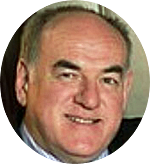

Some MAMS Characters on the Zambian Oil Lift
The Zambian Oil Lift kicked off in December 1965 and lasted through to November 1966. A great video covering some of the goings on follows and I've been able to identify some of the UKMAMS participants:
Ginge Singleton
Mike Green
Don Cleland
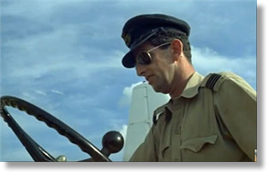
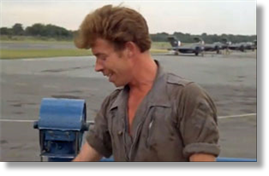
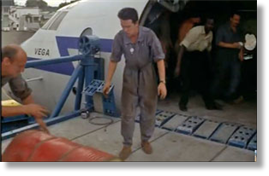

From: Ian Berry, Eastleaze, Swindon, Wilts
Subject: Jim Rice – Order of Service
Hi Tony,
Attached is a copy of the Order of Service for Jim Rice's funeral last week near Southampton.
Jim was on my team at Lyneham in the early 1980s. Unfortunately, whilst he was one of the first MAMS team members on detachment at RAF Port Stanley in the Falklands, he was 'first on the scene' after an incident. A Harrier accidentally fired off two sidewinder missiles whilst taking off; they ploughed straight through an Army working party injuring 11. It transpires that from this incident Jim developed PTSD in later life.
As part of his therapy he took up painting and a hidden talent was discovered. The picture on the back of the Order of Service is one of them. It was mentioned in the Eulogy that one of his paintings is now in a military museum but I know no more.
Regards
Ian
Subject: Jim Rice – Order of Service
Hi Tony,
Attached is a copy of the Order of Service for Jim Rice's funeral last week near Southampton.
Jim was on my team at Lyneham in the early 1980s. Unfortunately, whilst he was one of the first MAMS team members on detachment at RAF Port Stanley in the Falklands, he was 'first on the scene' after an incident. A Harrier accidentally fired off two sidewinder missiles whilst taking off; they ploughed straight through an Army working party injuring 11. It transpires that from this incident Jim developed PTSD in later life.
As part of his therapy he took up painting and a hidden talent was discovered. The picture on the back of the Order of Service is one of them. It was mentioned in the Eulogy that one of his paintings is now in a military museum but I know no more.
Regards
Ian

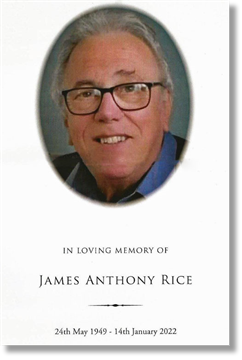
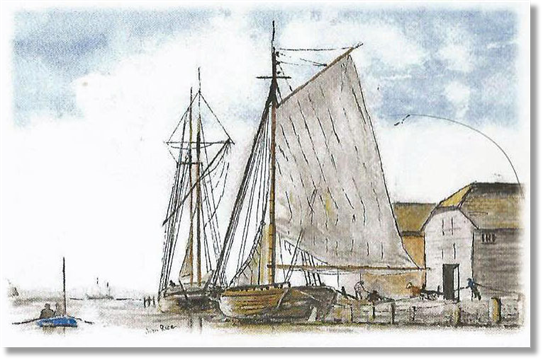
This Newsletter is Dedicated
to the Memories of:
Ian Priestley (RAF)
Colin "Fozzy" Foster (RAF)
to the Memories of:
Ian Priestley (RAF)
Colin "Fozzy" Foster (RAF)
Tony Gale
ukmamsoba@gmail.com
If you wish to make a donation,
you may use the above e-mail
through PayPal.
.
ukmamsoba@gmail.com
If you wish to make a donation,
you may use the above e-mail
through PayPal.
.







